
- solar electric yachts
- Soel Senses 62
- Soel Senses 82
- Soel Shuttle 14
- Custom model

SOEL YACHTS
Solar electric yachts.
With dedication and passion for high tech, sustainability and excellent design, Soel Yachts creates solar electric yachts that promise high efficiency, low emissions, outstanding comfort, low maintenance, and significantly reduced costs of ownership. We are driven by an unwavering commitment to accelerate the transition to sustainable and autonomous mobility on the water.

ENJOY THE RICHNESS OF THE SEA
Our solar electric catamarans combine all the elements for a luxurious and environmentally conscious aquatic lifestyle. With zero CO2 or noise emissions on board, you can reconnect with your senses and fully enjoy the journey.
electric models
The Soel Yachts portfolio offers solar electric catamarans for both private and commercial applications. With the vast experience gathered trough different projects worldwide and boats successfully performing on a daily basis for many years, we gladly can discuss individual requirements and find the ideal solution for your preferred electric yacht and destination
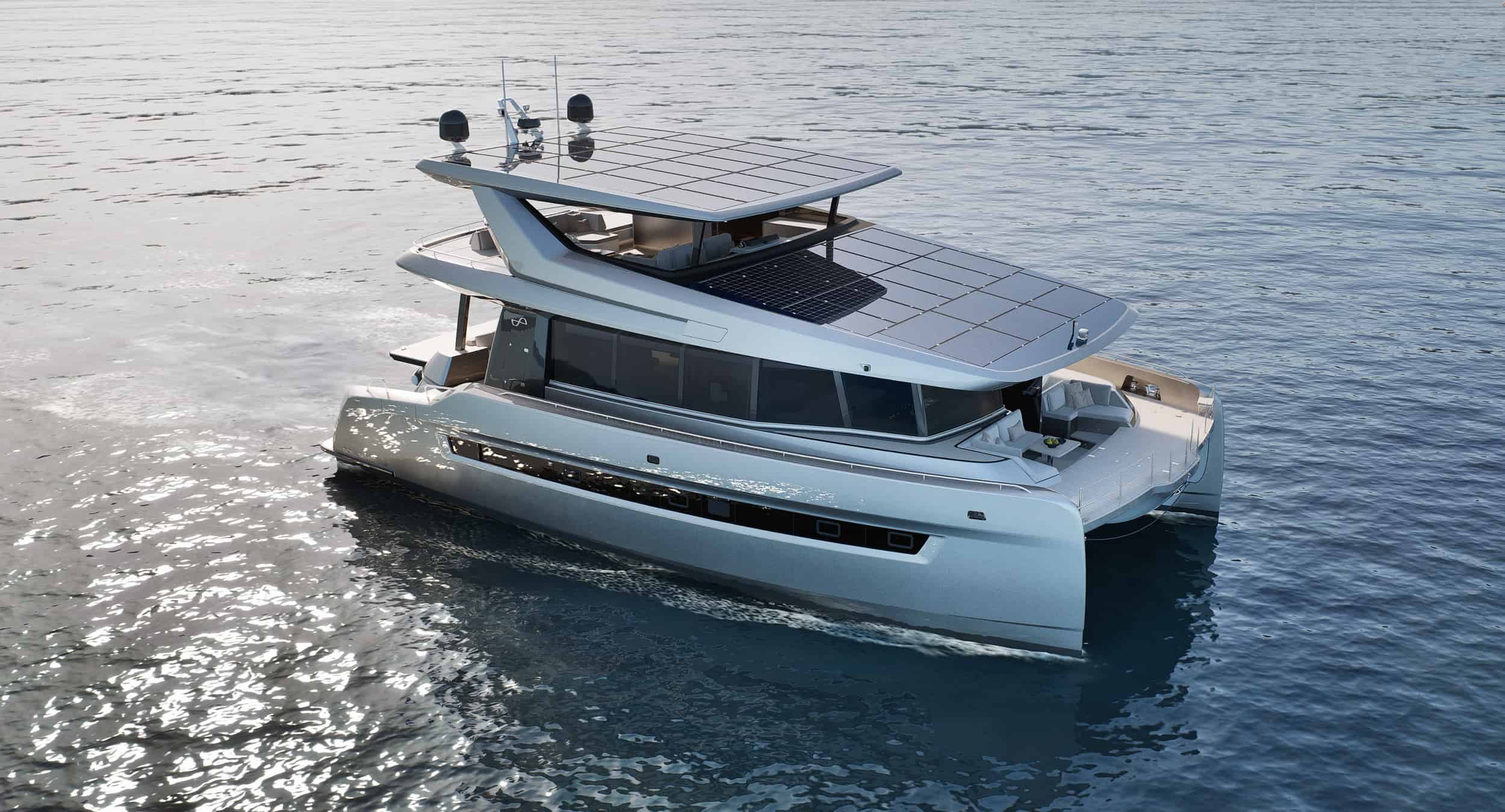
PIONEERS SINCE 2007
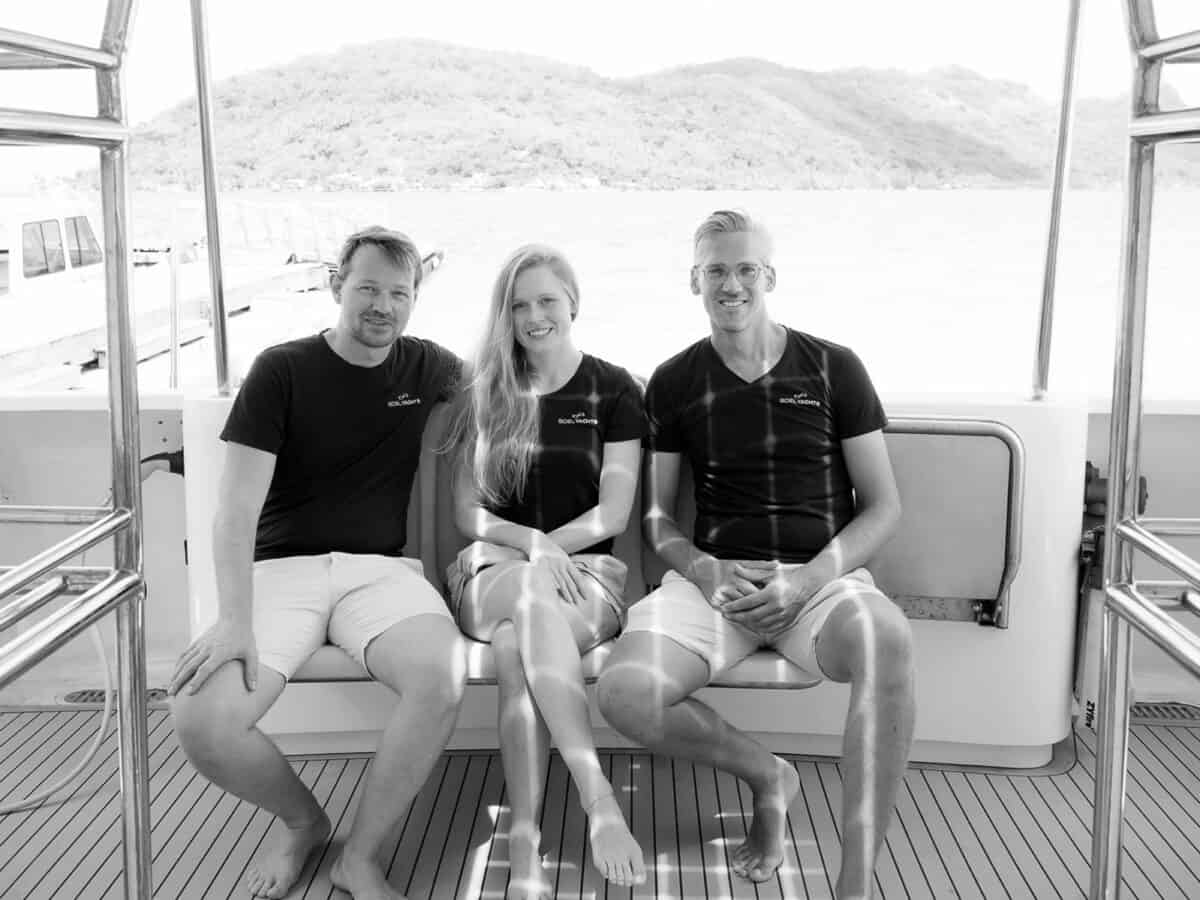
Bringing over 15 years of extensive expertise in electrifying solar electric yachts since 2007, we have been pioneers in the solar yachts industry. Our integral solar electric systems in-house have impressively powered more than 27 circumnavigations of the Earth across the world’s oceans, offering unmatched real-world testing and performance validation for an extraordinary and worry-free sailing experience.
LEARN MORE ABOUT US

INNOVATIVE TECHNOLOGY
At our core, we strive for the perfect balance between cutting-edge technology, purposeful design, and outstanding performance. Our innovative approach combines streamlined hull designs for electric propulsion, engineered in conjunction with our in-house systems, to ensure an exceptional range.
DISCOVER TECHNOLOGY
BOOK APPOINTMENT
It is undoubtedly the most effective approach to directly communicate your desires and preferences with one of our partners. They can provide you with a comprehensive presentation of the available options and take you on a virtual tour of your desired model. Our team eagerly awaits your message today to arrange your personalized appointment, which can be conveniently held either online or in person.
GET IN CONTACT


The ZEN50 is a game changer. World’s first series production catamaran equipped with a wingsail, it defines a new distinctive class of its own, where genuine zero-emission meets high comfort and performance, limitlessly.
Designed from scratch for ZEN Yachts by award-winning naval architect Julien Mélot , this full carbon catamaran is the ultimate essence of technology driven, high performance and luxurious, eco-friendly leisure yachting.
The blue water capable ZEN50 lightweight racing carbon hulls are combined with a huge solar roof for an unrivaled solar power vs. displacement ratio above 1:1 (18 kW / 17 tonnes), making this yacht completely energy self-sufficient. A revolutionary, fully automated, wingsail - by Ayro© - can be added as a range and speed extender. The yacht’s high capacity battery bank powers a powerful silent electric propulsion, allowing the ZEN50 to achieve 14 knots and maintain high continuous speeds in unrivaled safety and comfort, indefinitely…
The ZEN50 is offered with or without wingsail and comes in 3 main different versions: Racer, Cruiser and Explorer, each dedicated to a different usage and owner profile. We use these versions as a basis to define a final, bespoke specification for each of our valued clients and ZEN Community Members. Scroll down for more details, specifications and prices.

1st WINGSAIL series production yacht in the world!
The OceanWings32 - by Ayro© - was initially developed for Team Oracle, for the America’s Cup 2010 in Valencia. Over years, it has further been developed and automated by VPLP and was installed on Energy Observer in 2019. Two years of field feedback have allowed the Ayro team to fine tune the algorithm commanding the wingsail. The ZEN50 is the first series production leisure craft to be equipped with this fully automated wingsail. It is controlled at the touch of a finger on screens, is automatically adjusted and has several safety modes and features. The two parts of the wingsail can be hoisted and lowered independently and with the simple touch of a button. The wingsail OceanWings32 is the ideal complement for the solar roof for those wishing to cruise long distances off-shore with zero-emissions.
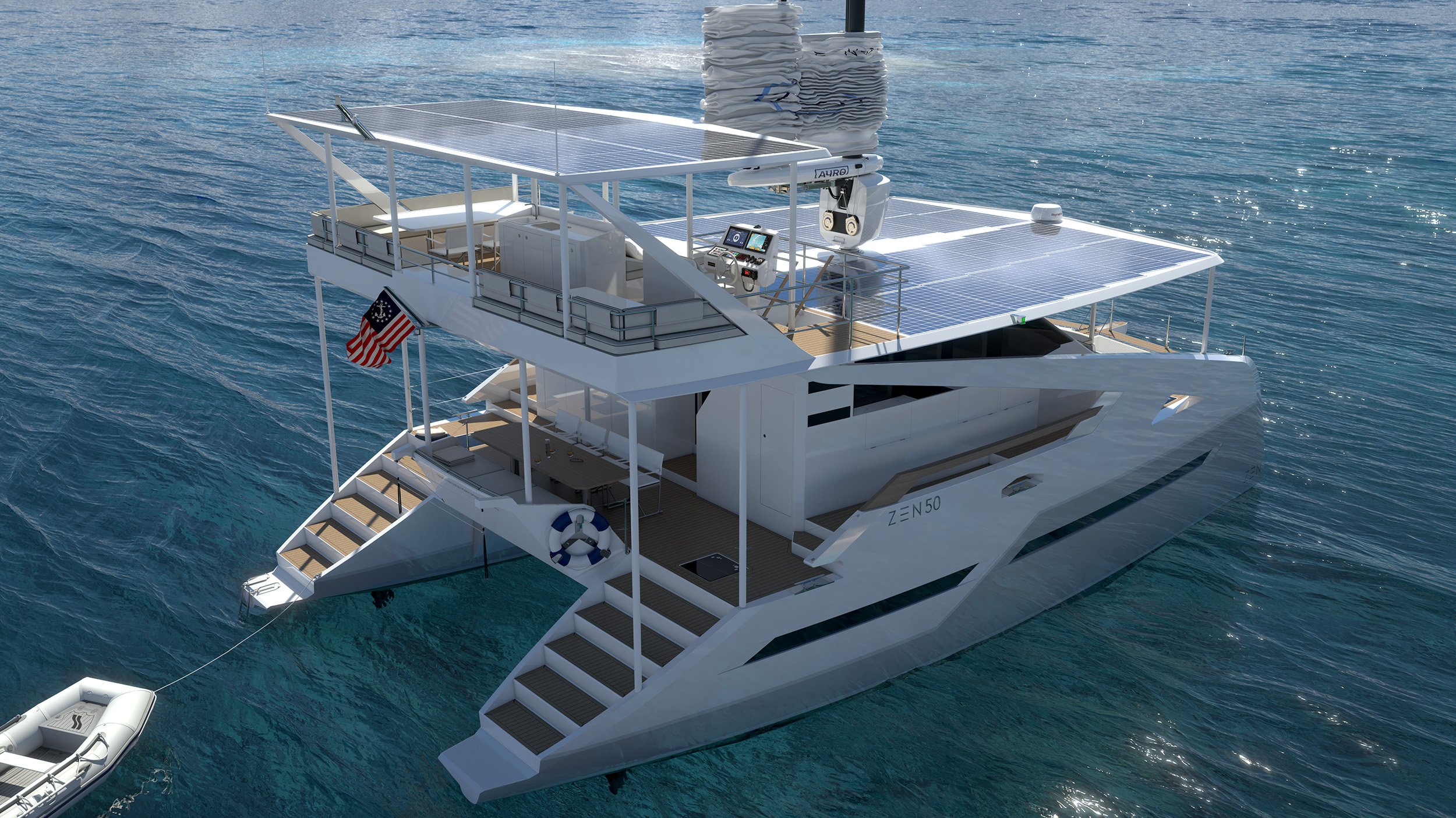
Greatest ratio SOLAR POWER / weight on the market
At 17 tonnes lightweight and 18,000 W of peak solar power, the ratio of the ZEN50 is at over 1 kW per displaced tonne of water or beyond 1:1 which is far beyond any other blue water CE Cat A yacht in this size range. Lots of solar power for little water to displace is the strong and healthy foundation the energy self-sufficient ZEN50 is built upon.
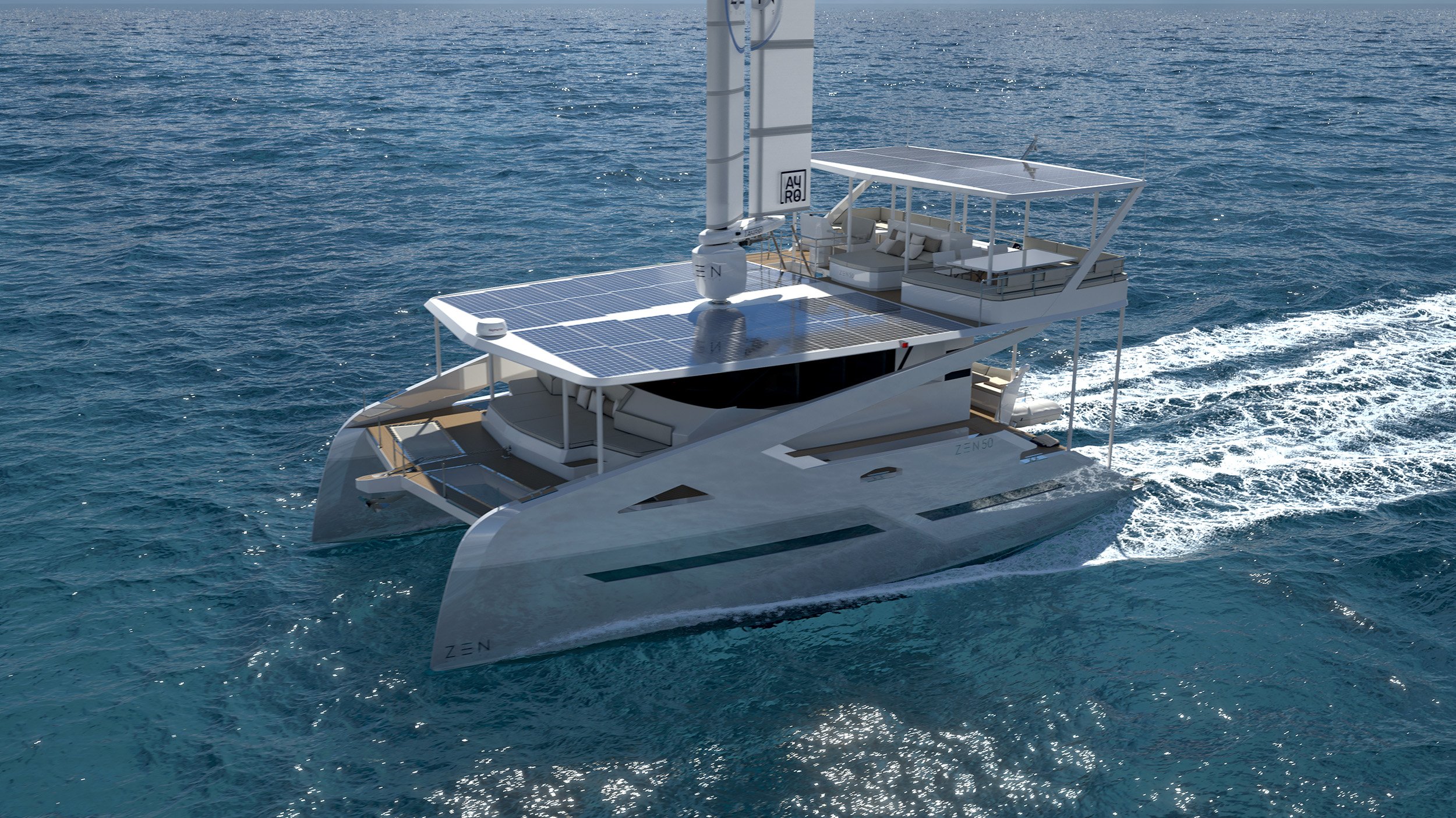
Performance CARBON sandwich hulls
The hulls of the ZEN50 have been designed from a blank screen for ultimate efficiency - understand minimum drag or minimal energy consumption for a range of speeds from 6 to 10 knots. Their shape is aggressive, sharp and slender. Their reverse bows cut through water like a sword cuts through butter and their curvature is reminiscent of graceful dolphin bodies. These hulls are undoubtedly of the performance type and are built with the best available composites: Carbon fibre and Corecell™. The combination of high strength, low weight and performance design allow the ZEN50 to reach speeds of up to 14 knots.
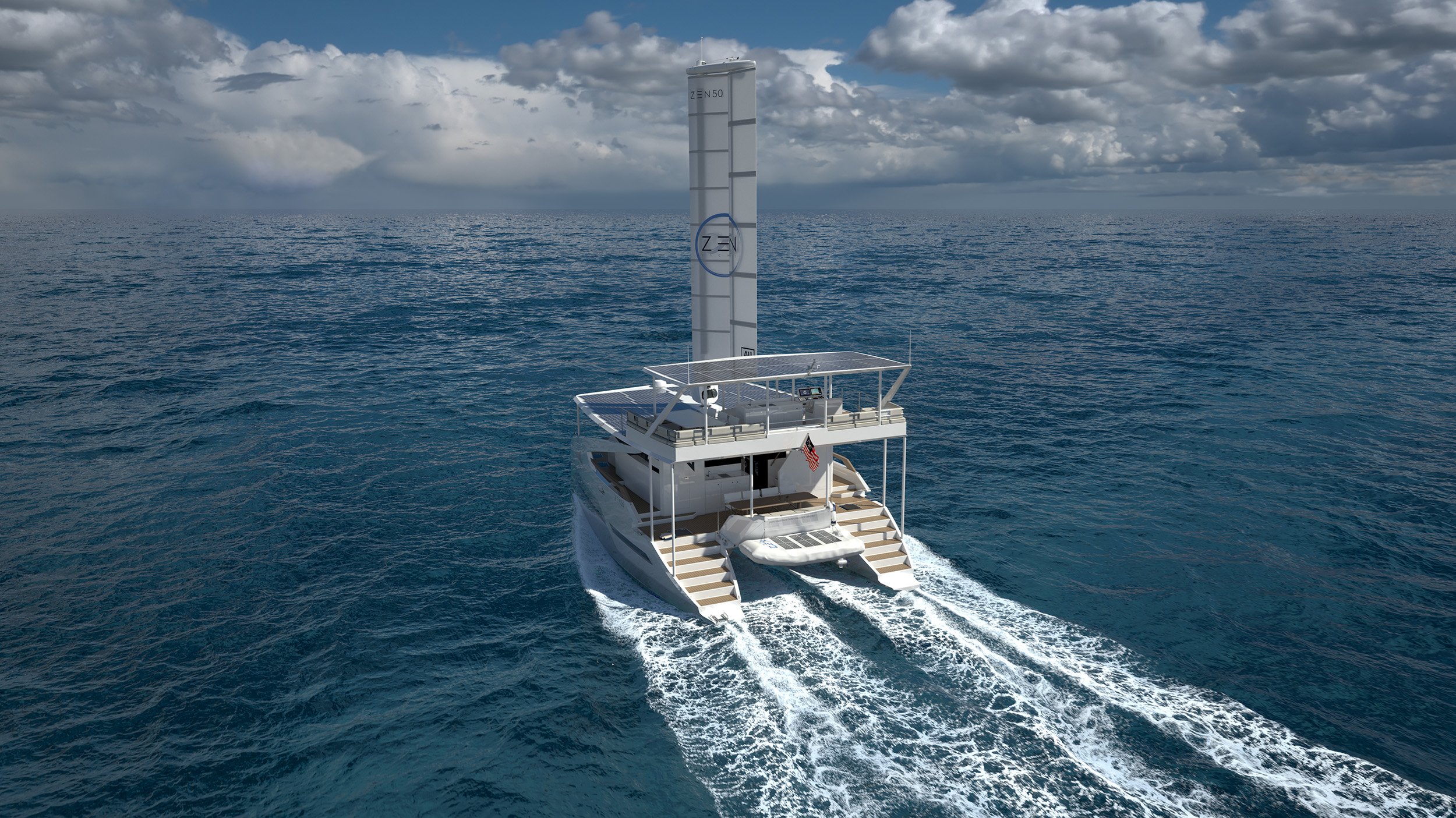
INFINITE range at high CONTINUOUS speeds
With maximized solar and wind power and minimized energy consumption… the ZEN50 can sail continuously at speeds varying between 6 and 10 knots. Thorough simulations in various sea states and weather system have consistently shown the ZEN50 will be able to achieve performance catamaran speeds continuously without using a genset. With the ZEN50, the world is your oyster and the wildest destinations are within your reach with this self-reliant vessel!

True ZERO-EMISSION operation
The first ZEN50 unit, whose construction started in March 2023, will not be equipped with a genset at all and will not have any fossil fuels onboard. The ZEN50 energy system with its very large capacity 160 kWh battery bank, has been designed to function for days in complete safety with minimal solar energy harvest and no wind. It is perfectly safe with no backup genset and operates 24/7 without any polluting emissions.
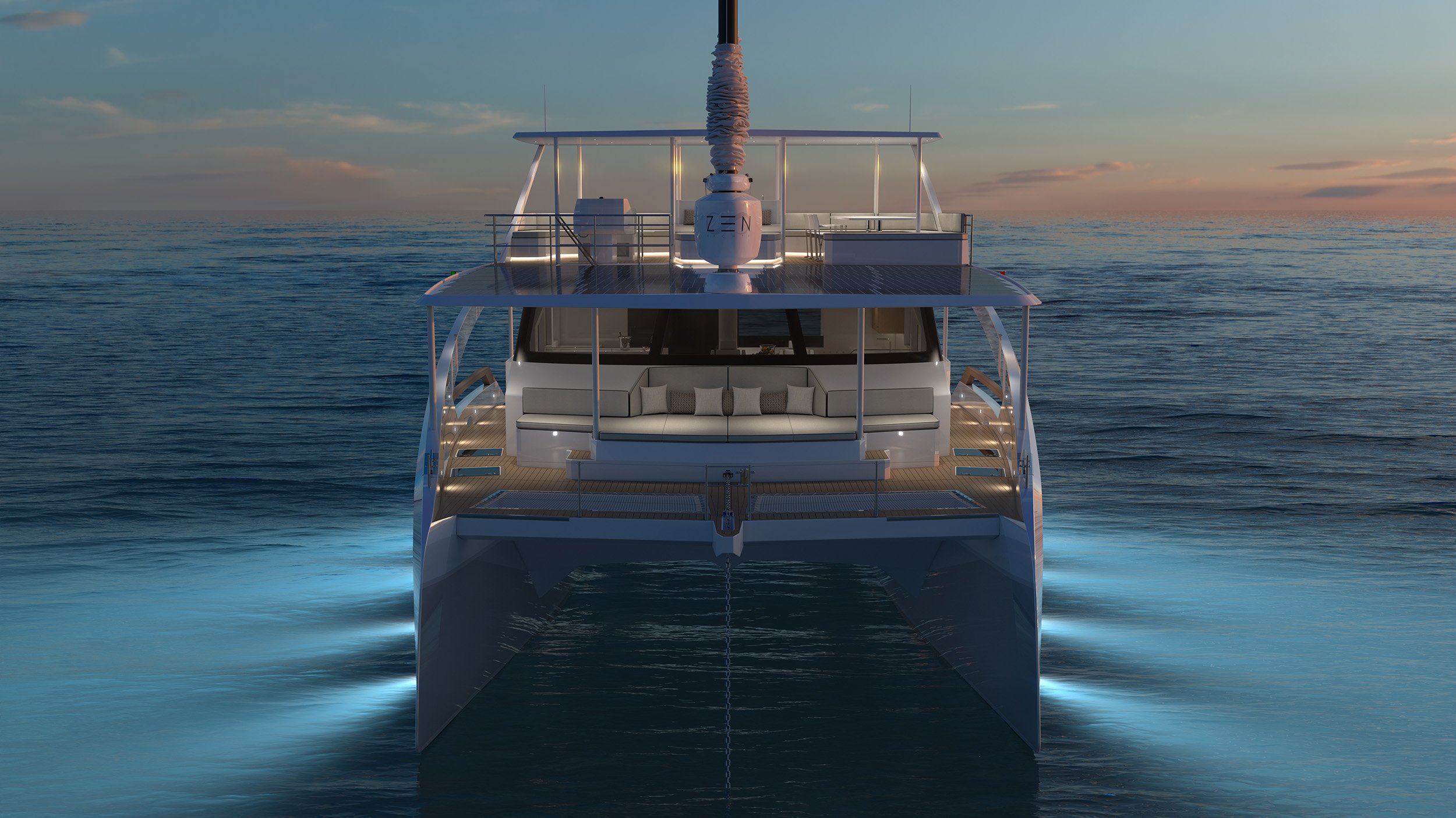
NO FUEL , no costs
Naturally, requiring no fuel to operate day in day out is great news for the environment, it is also fantastic news when sailing into remote areas where fuel bunkering might be near impossible or where the fuel quality might be an issue. Finally, it also makes a massive difference in this yacht’s costs of operation. Imagine the hundreds of liters of diesel saved over just a week, the obsolete engine maintenance schedules, the clogged filters and dirty tanks from another age… Welcome to a new burden-free, energy self-sufficient era, welcome to clean and graceful eco-yachting, welcome to ZEN Yachts.
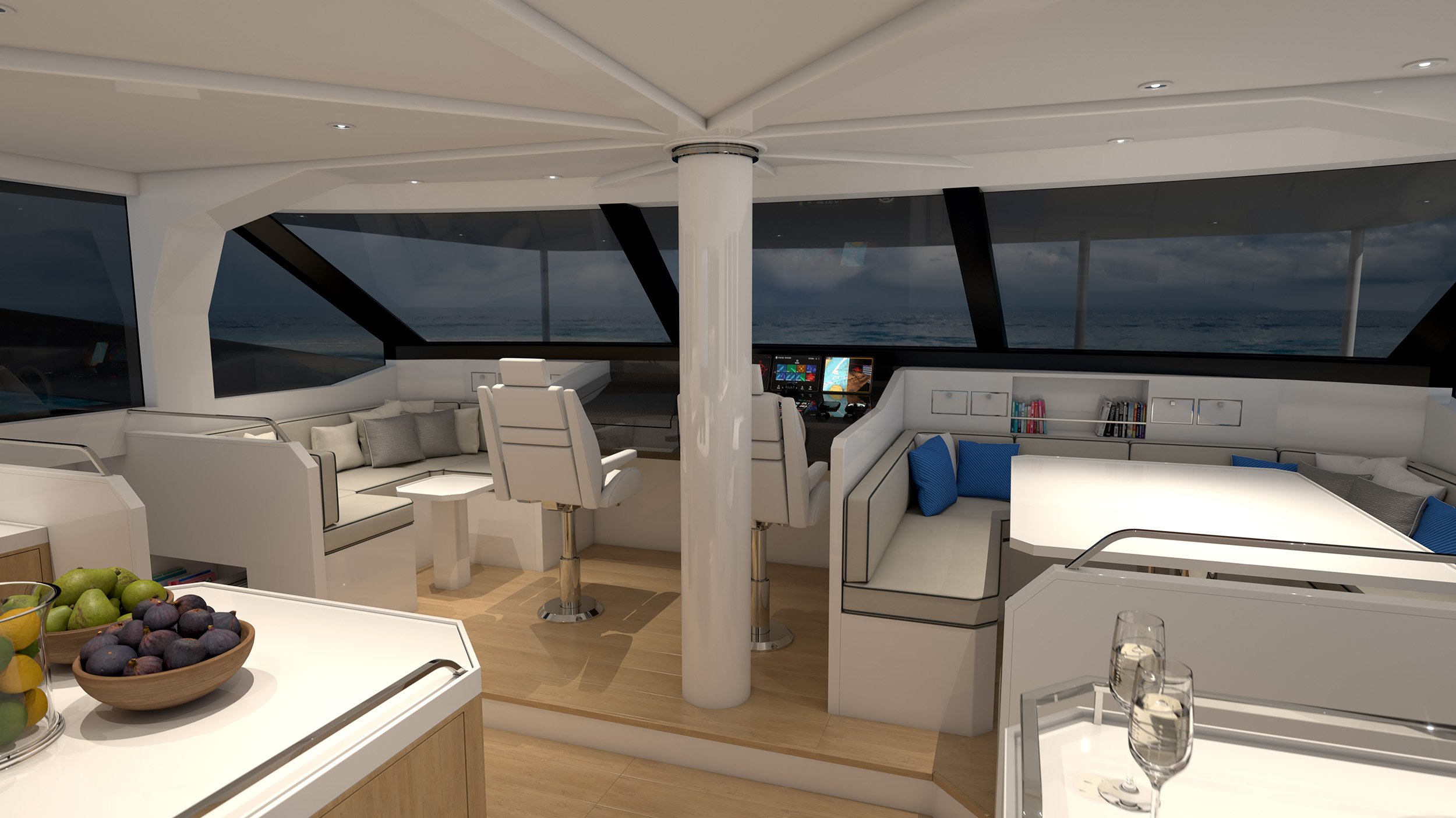
Highest SAFETY & reliability
At ZEN Yachts, we have made some design choices to attain energy self-reliance with the ZEN50 that reduces the habitable volume in the hulls, similar to performance catamarans. Where we have not and will never compromise is on safety. Our main voltage system is 48V making it perfectly safe to work on. The level of redundancy of the batteries and solar panels is 10! The main electrical architecture is split in 2 so that should anything happen on 1 hull, the entire vessel can still operate normally. There are 2 independent helm stations and the ZEN50 is packed with special safety features, nonsubmersible compartments and we can even offer an in-depth practical course on safety equipment usage and management. Sailing with the ZEN50 is not only exhilarating and clean, it is ultra safe!
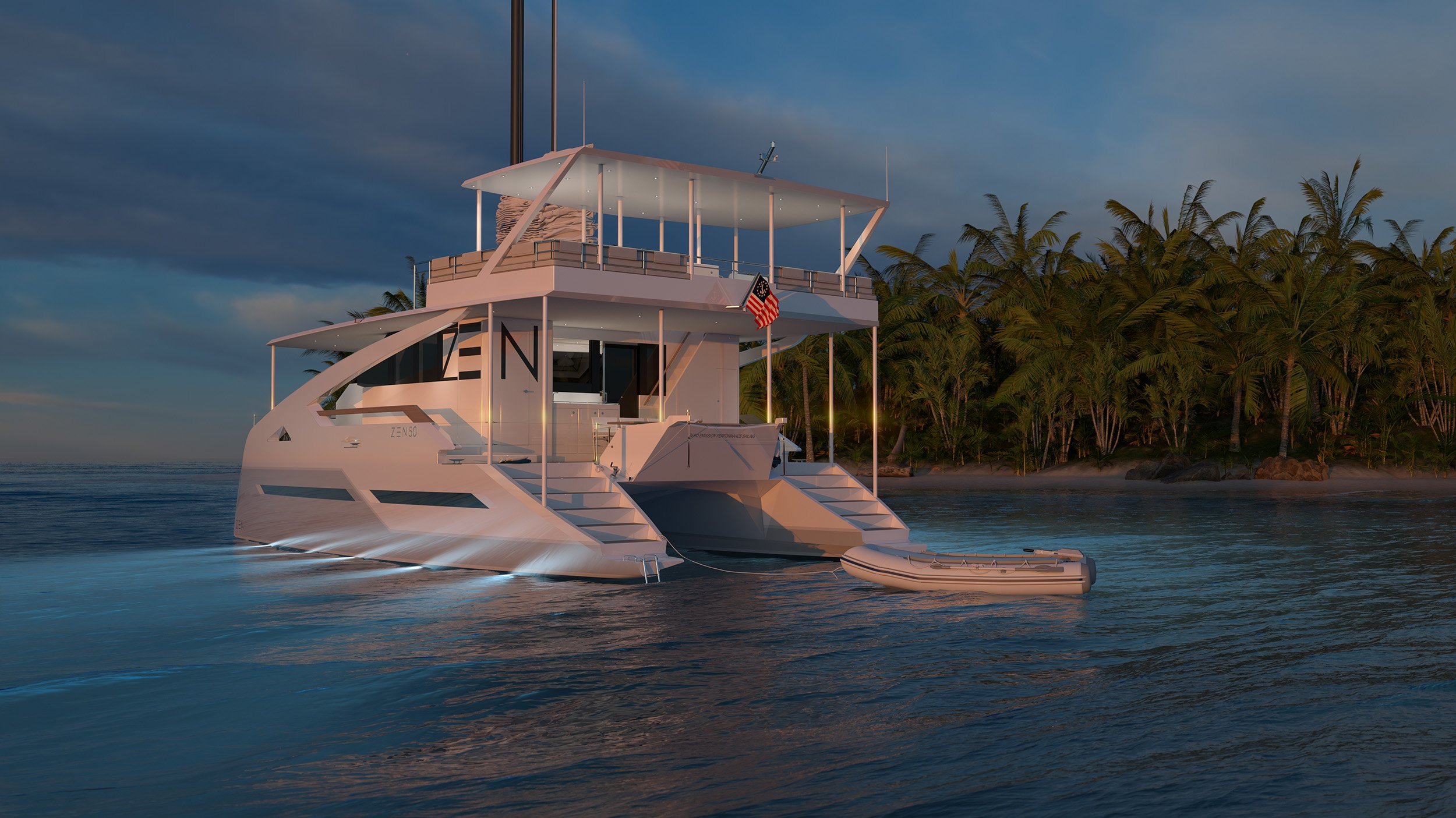
Unrivaled space & COMFORT
The ZEN50 offers the speeds of a performance catamaran, the comfort of a large motor yacht and the simplicity of an electric car. No less than 2 large day beds, 3 dining areas for over 10 people, 1 professional galley and 2 wet kitchens, 5 heads, up to 4 double ensuite cabins, 1 bunk double and 1 single together with both saloon and dining areas converting into extra sleeping areas, this is simply unrivaled on a 50 ft. catamaran. Add an electric tender, dive compressor, satellite internet, 2 helm stations (cockpit and flybridge), a solar roof that converts into a gigantic upper deck to enjoy the most epic sunrises and sunsets, welcome onboard the ZEN50!
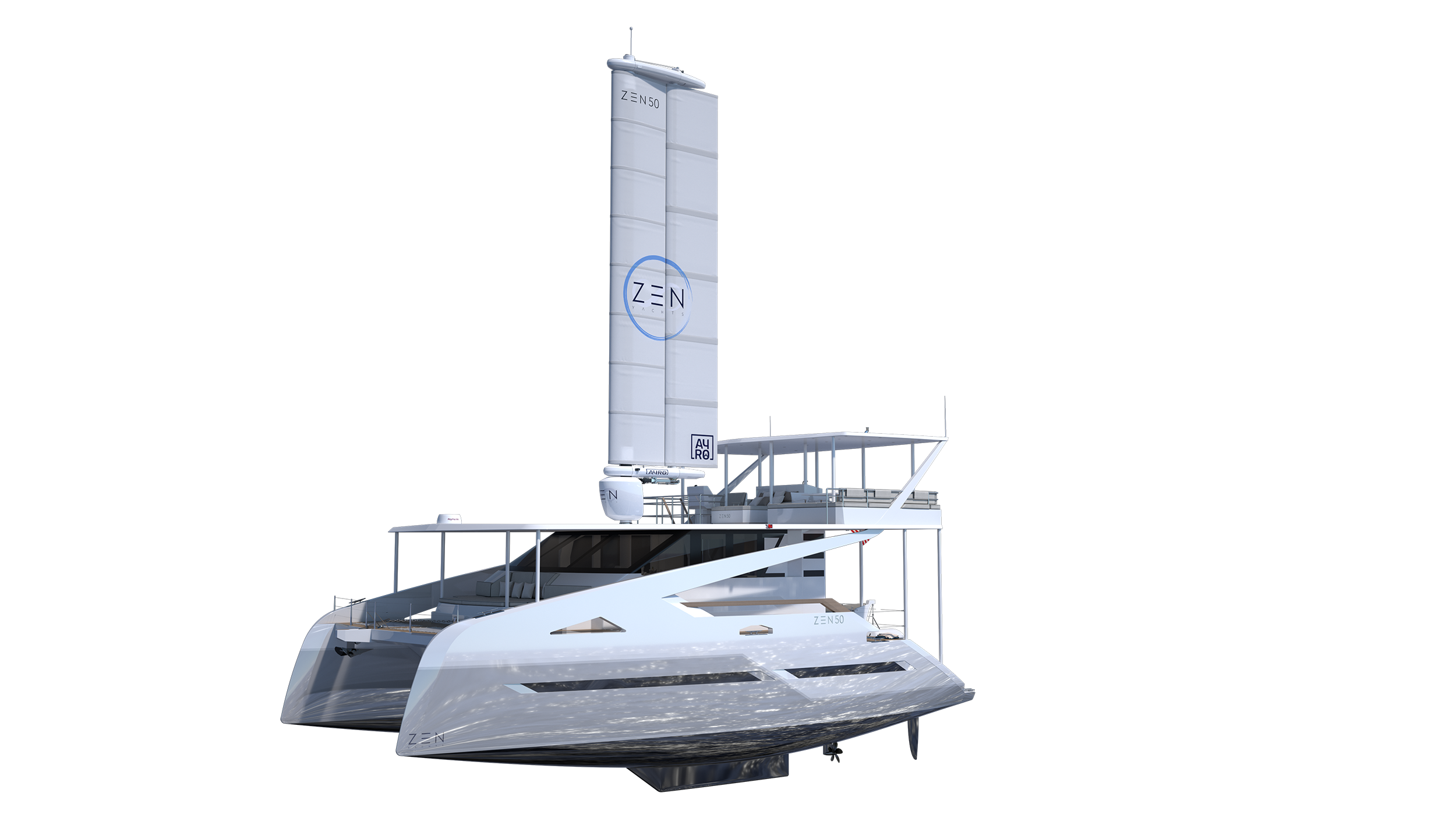
SPECIFICATIONS
Main particulars.
• Length Over All: 15.7m
• Beam: 8.4m
• Depth Molded: 2.7m at midship
• Displacement (light) : 17 T
• Draft (design): 1.3m (4.3ft) incl. keel
• Passenger Capacity: 12
• Berths: 12 (4 x double + 2 x single + saloon)
• Building Material: Carbon Fiber - Corecell™ composite
• Certification: CE Cat A - Unrestricted with 12 persons
Note: Some of the above figures may vary between versions
PROPULSION & ENERGY
• Propulsion: 2 x 50 kW brushless DC motors
• Main Battery Pack Capacity: 160 kWh Lithium
• Solar Roof Peak Power: 18 kWp
• Wingsail: Oceanwings® OWS 3.2 by Ayro©
• Backup Battery Pack Capacity (Nav/Com/Wing): 5 kWh Lithium
• Main System Voltage: 48V - Low voltage for total human safety
• Accommodation Voltage: 110V or 220V
SPEED & RANGE
• Max. Speed on e-motor only: 10 kn
• Max. Speed on e-motor & Wingsail: 14 kn
• Cruising Speed for continuous operation - solar only: 4.5 - 5 kn
• Cruising Speed for continuous operation - solar and wing: 6 - 10 kn
• Cruising Speed day time: 8 - 10 kn
• Range Over 24 h: 180+ nm
Note: These values may vary between versions and sea / weather conditions
EQUIPMENT INCLUDED - RACER VERSION
• Integrated power management system
• Solar power & energy storage system
• Electric propulsion system
• By-wire steering system
• Helm stations at cockpit & flybridge
• Galley counters, storage, sink, oven, stove, fridge, freezer
• 4 en suite heads with enclosed shower, toilet, sink & faucet (in each head)
• All cabin furniture (as shown in layouts)
• Aft deck fixed dining table and aft sofa with collapsible back rest (as shown in layouts)
• Fore deck day bed and lateral seats (as shown in layouts)
• Outdoor marine cork decking / indoor saloon natural bamboo decking
• All cushions In/Outdoor upholstered with Sunbrella® fabric
• 6 deck hatches
• 2 x 500 liter (2 x 132 gal) fresh water tanks
• 2 x 100 liter approx. (2 x 26 gal) fresh water tanks + 1 fresh water pump
• 2 x 350+ liter approx. (2 x 92 gal) holding tanks
• Railings, cleats and fore deck trampolines
• Mooring equipment: 33 kg Rocna® stainless steel anchor + 50 m stainless steel chain 10 mm + 150 m nylon rope + e-windlass
• Regulatory navigation equipment including navigation lights & mast
• 2 x chart plotter 16”; 2 x VHF with DSC button
• Regulatory Life Saving Appliances
• Critical spare parts kit
Note: The above equipment is for the Racer version. Cruiser & Explorer versions carry additional equipment
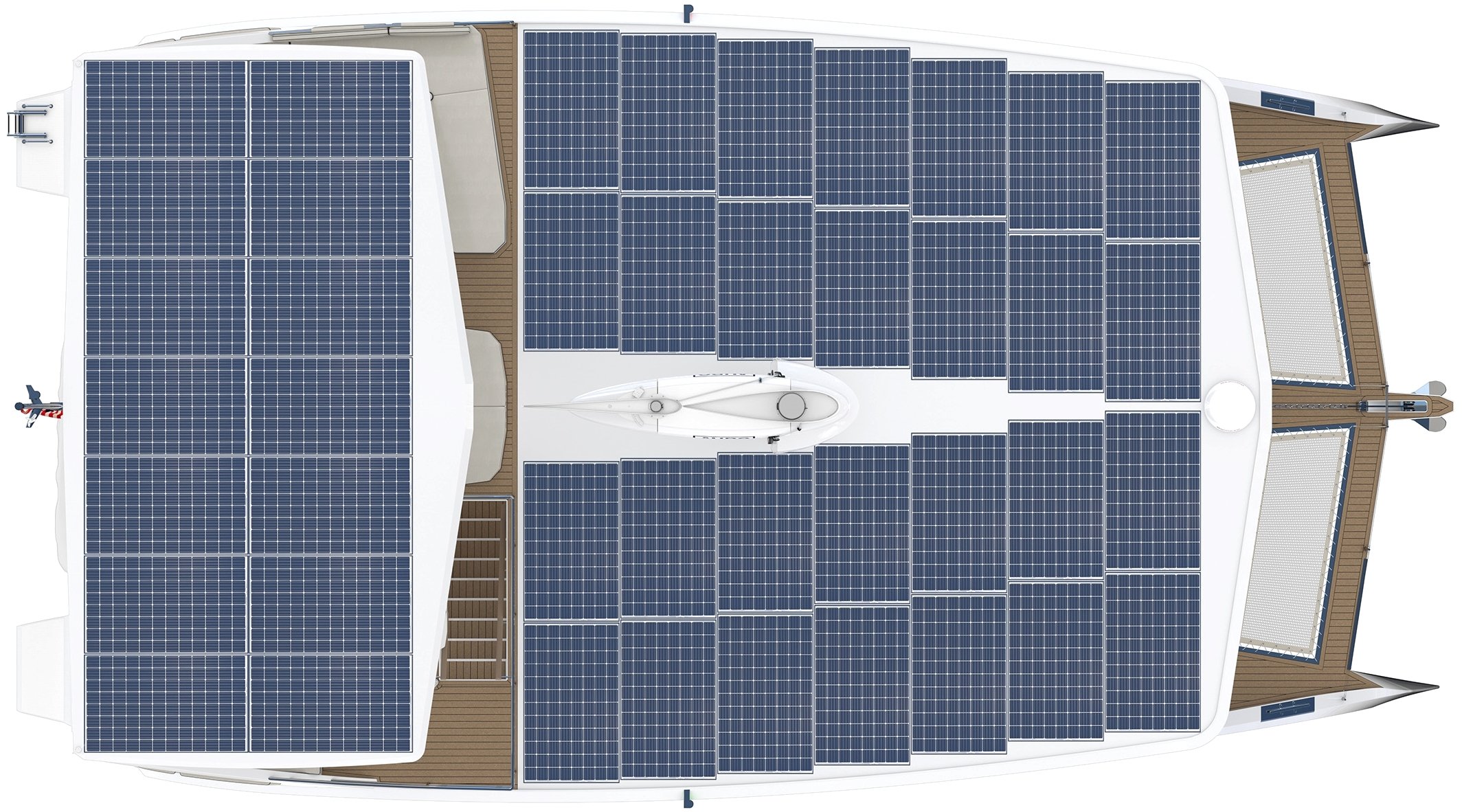
ZEN50 Solar Wingsail Electric Catamaran - Solar Roof Layout

ZEN50 Solar Wingsail Electric Catamaran - Flybridge Layout
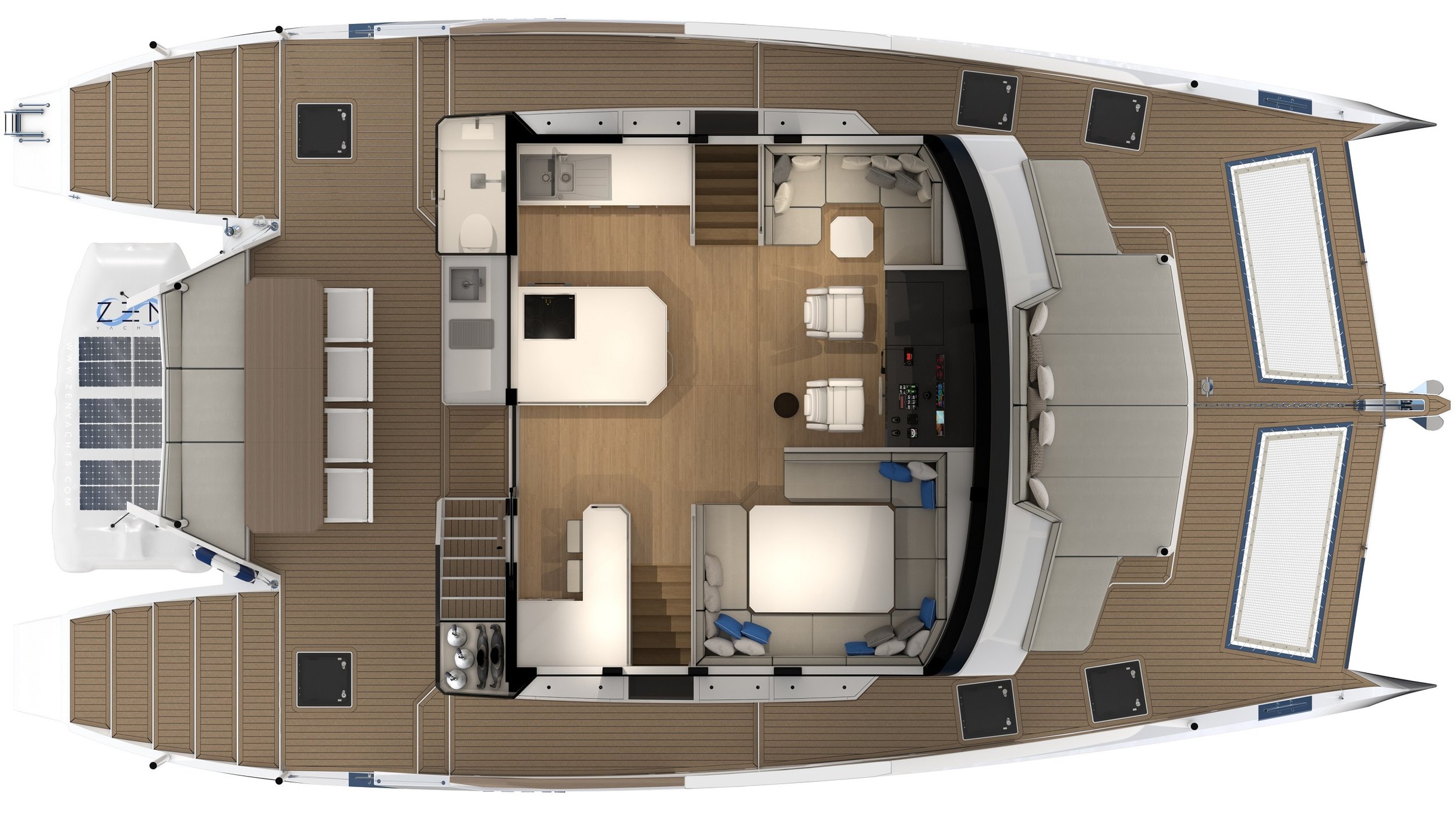
ZEN50 Solar Wingsail Electric Catamaran - Main Deck Layout - Asymmetric D (subject to changes)
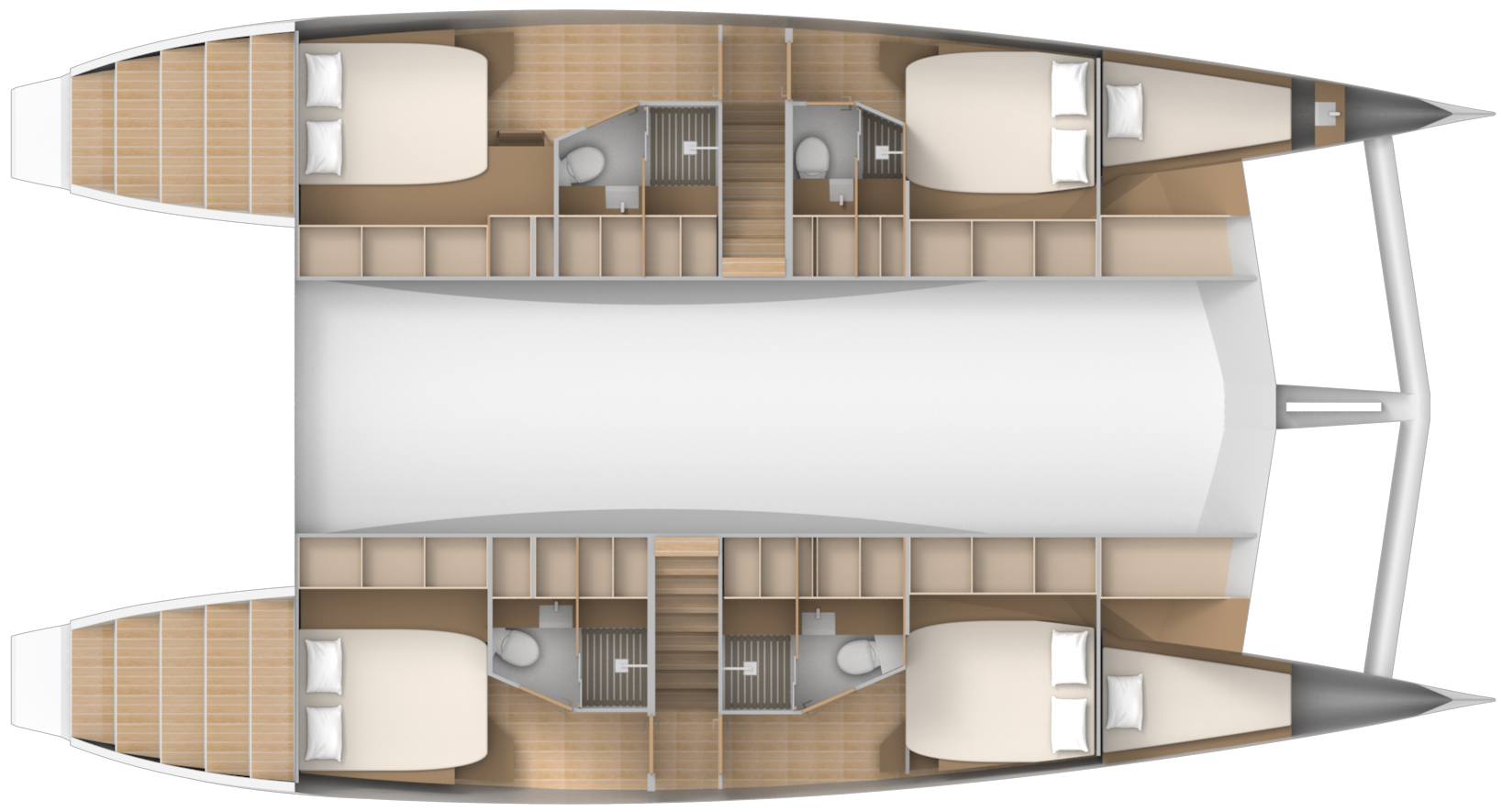
ZEN50 Solar Wingsail Electric Catamaran - Cabin Layout - Asymmetric D (subject to changes)
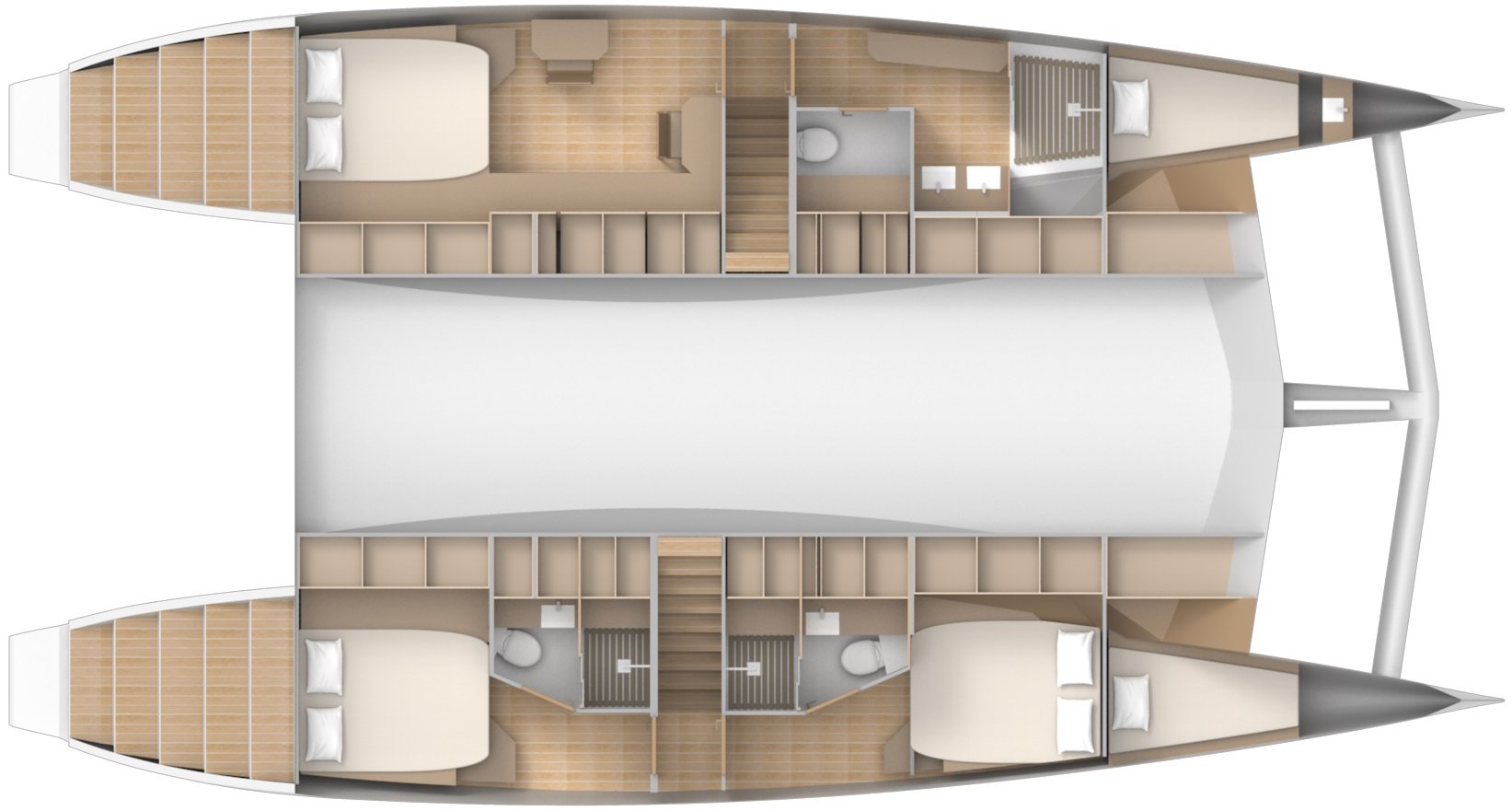
ZEN50 Solar Wingsail Electric Catamaran - Cabin Layout - Asymmetric E (subject to changes)
SOLAR & WINGSAIL
OCEAN RACER
Solar power & Wing, basic configuration, navigation, safety, fridge, etc.
EUR 2 150 000
WORLD CRUISER
Solar power & Wing, well equipped with A/C and water maker
EUR 2 400 000
ARCTIC EXPLORER
Solar power & Wing ultimate configuration with all available options
EUR 2 650 000
Solar power, basic configuration, navigation, safety, fridge, etc.
EUR 1 700 000
CONTINENTAL CRUISER
Solar power, well equipped configuration with A/C and water maker
EUR 1 900 000
TROPICAL EXPLORER
Solar power ultimate configuration with all available options
EUR 2 100 000
Ready to reserve your ZEN50?
Want more information .
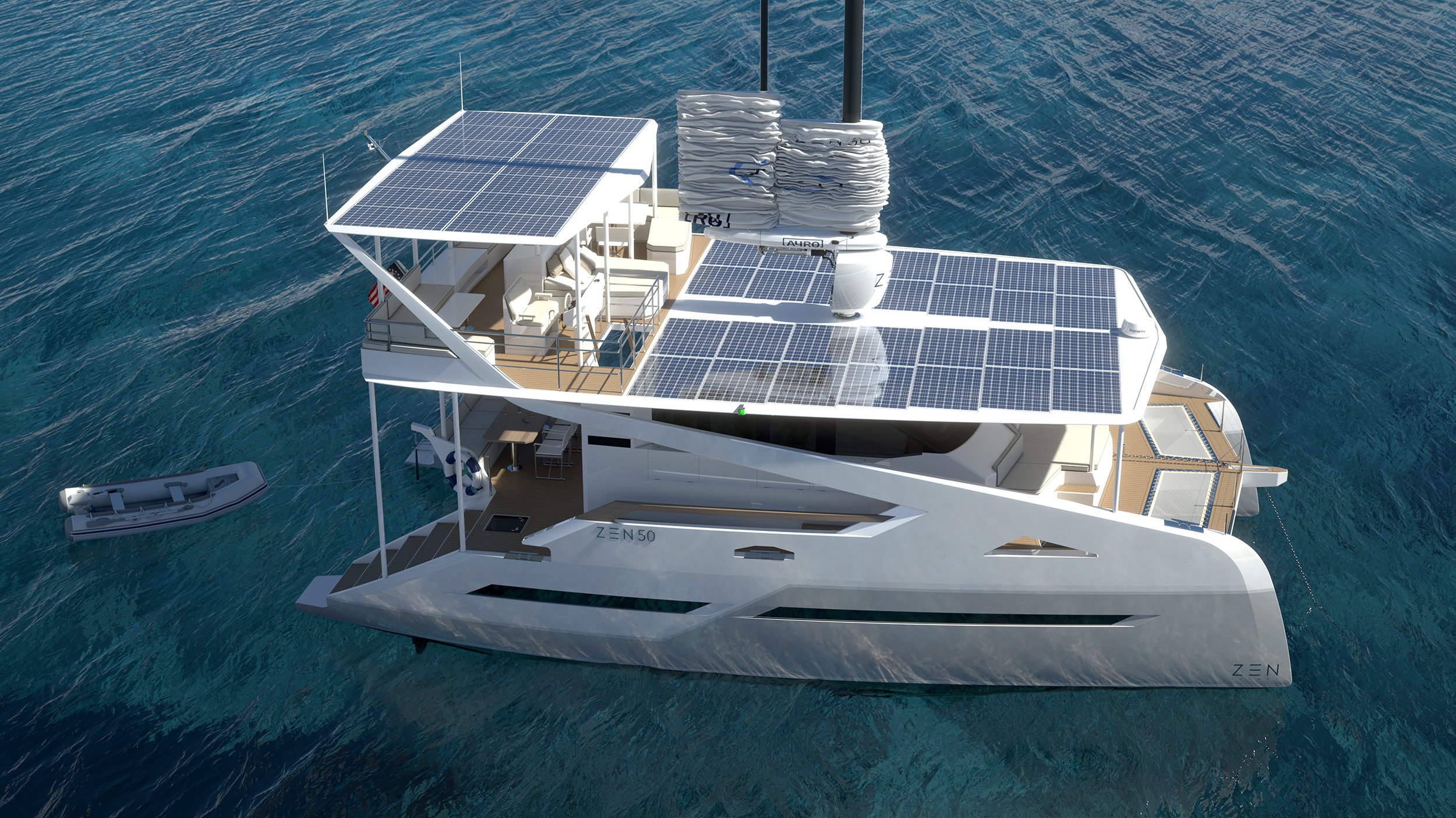
- Yachting World
- Digital Edition

Review: Silent 55, the extraordinary solar powered yacht
- January 18, 2019
Silent Yachts is tapping into the solar zeitgeist and creating a new meaning for the term ‘powercat’. Sam Fortescue reports

There is a slow, silent revolution under way in the yachting world. It is a revolution that is introducing tonnes of lithium and a sprinkling of silicon to the spec list of new boats. Holding out the promise of silent mobility, plus limitless domestic power on board, it made a big splash at the last Cannes Festival of Yachting – not least thanks to the new Silent 55 catamaran which debuted there.
From the pontoon side, the Silent 55 looks like a typical modern catamaran, with a big coachroof studded with windows and a flybridge helm. Except there’s no mast. Now, bear with me here. I realise that this is a sailing magazine, but we will shortly get back to more familiar territory. The unique qualities of this catamaran only become apparent from up top, where an expanse of solar panels stretches away fore and aft, embedded into the coachroof. The hard top itself carries yet more panels, and can be folded down flush to give an unshaded solar array of 49m2. During the heat of a summer day in the Med, this is capable of generating 10kW of power and up to around 60kWh in the course of the day.

But to make a solar system work in reality, Köhler had to go back to the drawing board on yacht design. The saloon and hulls have extra thermal insulation to keep air-con losses down, and the use of carbon and aramid in key areas helps reduce the overall weight to a decent 17 tonnes (a Lagoon 52 weighs 22.5 tonnes). He has tried to keep windows out of the direct sun with long overhangs and in contrast to the Lagoon’s 12 deck hatches, the Silent 55 has just two.
Holistic design
On the other hand, it has lots of opening windows, to allow a natural draught to do its job. “It’s a holistic approach – you can’t take the batteries and the drivetrain and drop it into another boat.”
Of course, using the propulsion system quickly takes its toll of the boat’s 140kW battery bank. The model on display at Cannes had two 135kW motors, giving you just half an hour of silent motoring flat-out, albeit at a top speed of over 20 knots. More reasonable 30kW engines and a single-digit speed give you greater range. Nonetheless, the electric drive alone isn’t going to allow you to outrun a storm, or race home after a day at anchor, so the boat is designed to work with a generator hidden in the heavily insulated transom of its starboard hull. At cruising speed of around 5-6 knots, Köhler says there is rarely any need to use the generator, citing an owner who has just emailed him triumphantly about a second year totally generator-free. “In the end, you have to compare it to the performance of a sailing boat,” Köhler says. “It is as fast as a sailing boat in similar conditions – after all, there is no wind without sun.” He went so far as to tell me during the sea trial in Palma, Mallorca, that he believed the majority of sailors would happily dispense with the hassle of sails and a rig if only they could enjoy silent motoring and anchoring. “As soon as people realise the incredible concept of this boat, they won’t understand why they ever did anything else.”
The market does not seem to agree with him – yet. Sales of the boat have been good – they have already sold six, five of which are already in the water. But of those, four customers have taken the sail option, which means planting a 19.7m tall mast complete with boom and rigging slap bang in the middle of the coachroof solar array. “I was a bit amazed,” Köhler admits. “The shade from the rig reduces the energy generated by the solar area, while it costs more and is heavier, so consumes more fuel. Maybe it is for optical reasons.” In fact, the shade of the rig slashes the average yield of the solar panels in half. In the Med, that means around 30kWh per day. But perhaps it figures. The typical profile of buyers is an environmentalist who has a Tesla electric car and is “an early adopter who likes to have things before others”. And at low speeds, with modest use of the air-con, the reduced energy generation should still cover daily consumption.

The performance under sail should be reasonable because of the lightweight build of the boat, its broad 8.47m beam and stub keels added to each hull. Control lines are led back via conduits in the coachroof to the flybridge helm station, to make single-handing under sail a possibility.
More interesting, I think, is a sort of halfway-house option using a kite rig. This optimises the performance of the solar panels and gives plenty of propulsion. On the smaller 55 and the 64, Silent Yachts currently recommends a 19m2 kite that costs around €25,000 – a fraction of the cost of a new mast, boom, shrouds and sails. “The sail automatically makes a figure of eight above the boat, and you can steer it with a joystick or an app on an android phone,” Köhler explains. “It can propel the 55 at up to 6 knots, even in light winds.” Perfect for an Atlantic crossing, then.
For the bigger Silent 79, which will hit the water in the summer, a commercial grade Sky Sail system needs to be used – a smaller version of the ones used on cargo ships. This kite can propel the boat at ten knots, but it costs more than ten times as much as its smaller cousin. Both are capable of pulling the boat upwind. So far, so new. But outside the novel energy and propulsion system, the Silent 55 aims to do what many other cruising catamarans are trying to achieve. “Most of our clients order for circumnavigation and long-term cruising,” Köhler says. So the boat is aimed to be as comfortable and capable as possible with watermakers, TVs and an induction hob that all capitalise on the boat’s abundant energy. A flexible configuration allows owners the choice of between three and six cabins – the latter designed for charter. The owner’s cabin lies forward of the saloon, under the windows of the coachroof, which provide magnificent views and abundant natural light. There’s a walk-around bed and steps down into the starboard hull give access to an en-suite shower room and heads.

In my view, the best cabin lies aft of this, accessed in the traditional manner down steps out of the saloon. The king-sized bed lies athwartships and the shower is larger than that of the master cabin. There’s more space down here, better headroom and still plenty of light courtesy of the many hull lights.

When I had the chance to sea trial the Silent 55, albeit in motorboat format, I jumped at it. It was a contrary autumn day on Mallorca with 15 knots breeze – just a shame, then, that this wasn’t one of the sailing configured versions.
To start with, getting on board is made really easy courtesy of deep boarding platforms on the skirts. She feels rather square because of that vast, glazed saloon with its deep overhang, and perhaps because of the utilitarian nature of the hard top, which is really about supporting more solar panels. Nevertheless, the side decks are broad and uncluttered. The space up top is designed to concertina down flat, hence the hydraulic rams, fold-down seat back and lowering console. It makes a great sailing position, though, with all round visibility, and is also perfect for sundowners at anchor. When the rain comes down, this feels quite exposed, but there is a fully sheltered helm at the front of the saloon, and it is also possible to drive the boat from anywhere using a tablet thanks to smart electronics. Under power, the handling is superb. The quietness of the motors is astonishing, and I gather they’ll be inaudible on the next boat, which will do away with the gearbox. Even in the aft cabins, directly above the motors, there is no more than a distant hum. The boat responds instantly to the power and the wind seemed to have no impact at all. As with any propulsion system, the power consumption jumps as you pile on the speed – it was sobering to see. At 6 knots, both motors drew 10kW but at 8 knots it was closer to 30kW. I liked the huge saloon with its raised table for 360º views. And the sliding door and window gives great access aft, connecting the saloon and cockpit in fine conditions. The finish was smart and in muted tones, feeling more Scandinavian than German.
Intriguingly, at least it seems to me, Köhler has tapped into something with the concept behind Silent Yachts – but not entirely for the reasons that he expected. Buyers are opting for the sail or kite versions of the boat because they want a comfortable wind-powered craft with abundant, quiet energy on tap. It brings a whole new meaning to the term ‘powercat’

Multihulls: new yacht reviews
Yes, the racing world is stretching the boundaries, with 100ft foiling maxi trimarans tearing around the globe and F50s, the…

Multihulls: owners’ experiences and reviews
They have two different boats, different sailing plans and two very different sets of experience. But what these cruisers have…
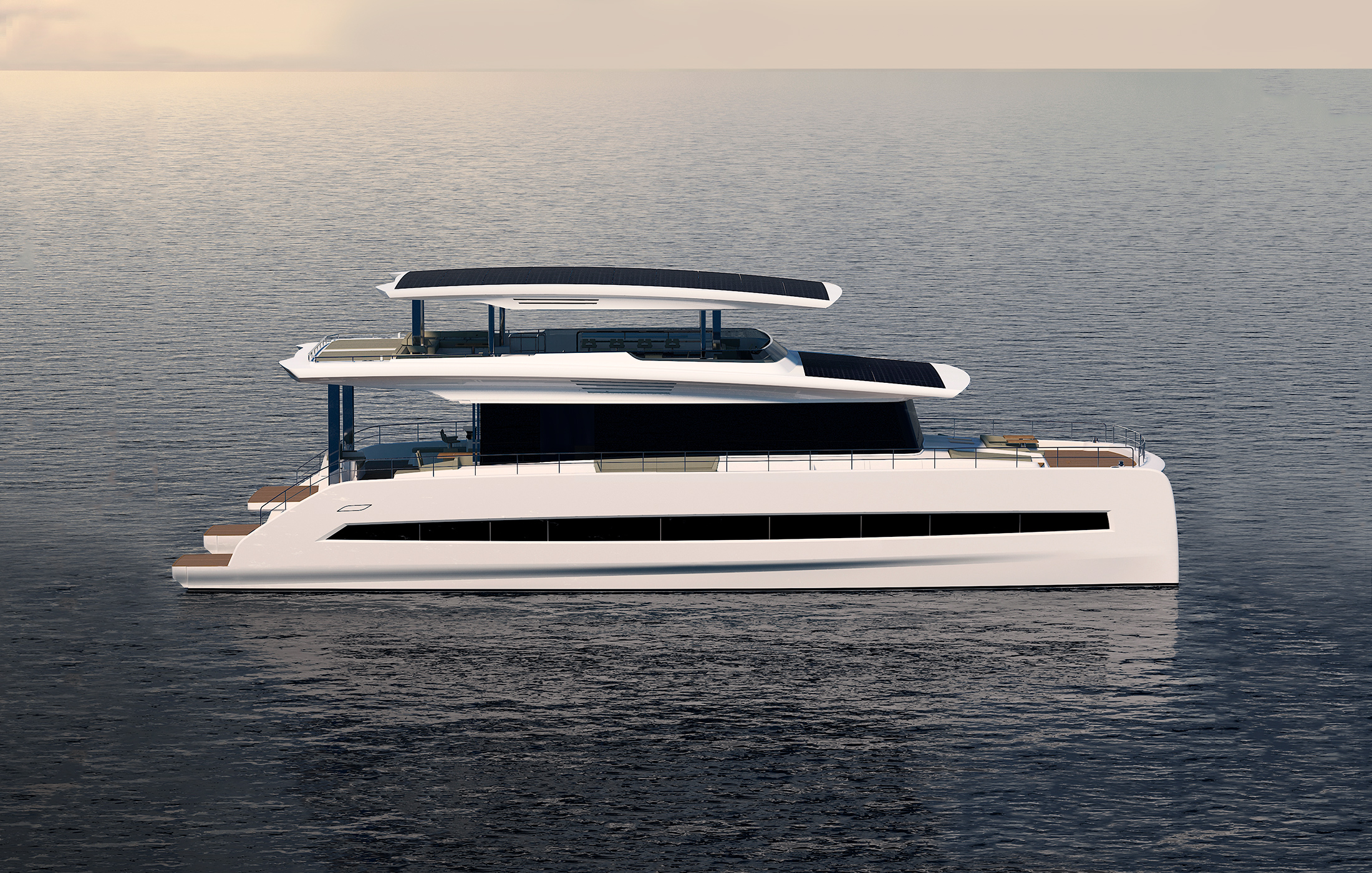
Timeless design meets state-of-the-art technology
More spacious, bolder with premium levels of elegance and comfort. The 80 Series combines our state-of-the-art solar electric drivetrain with unmatched refinement. Her timeless exterior and modern interior features bespoke design by none other than renown Italian yacht designer Marco Casali. Highly advanced hydrodynamics make for an incredibly smooth cruising experience. She can be either configured with a flybridge or as a 3-deck version and can easily accomodate additional crew.
Specification
Deck options, silent 8o 3-deck open.
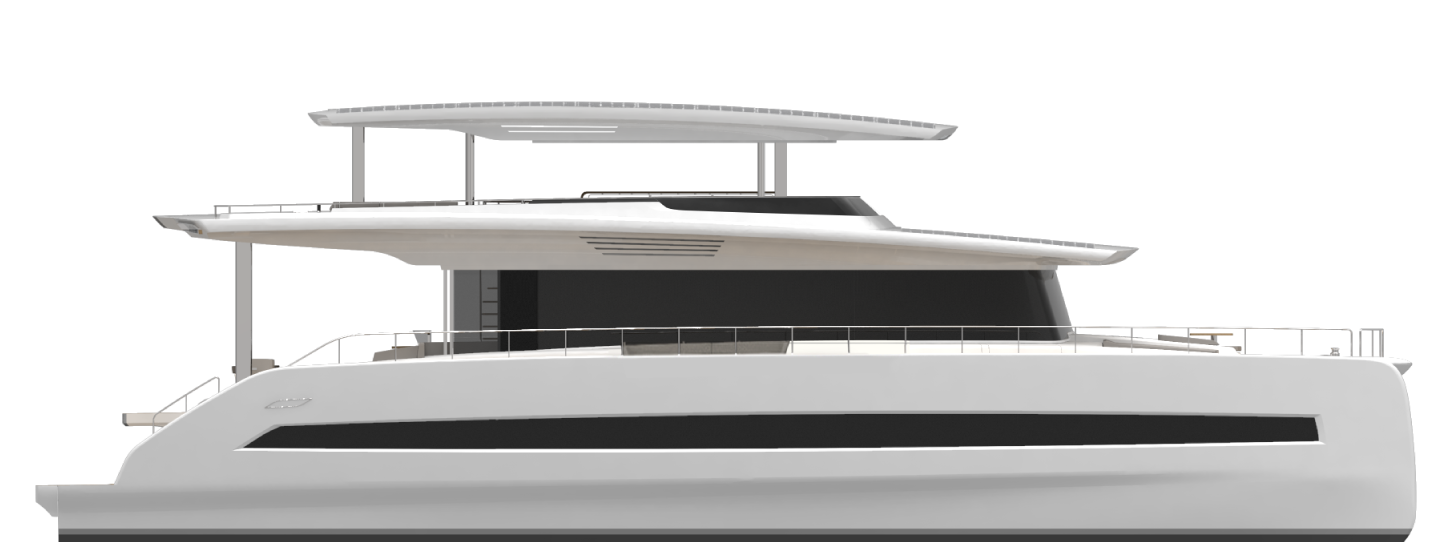
A complete third deck instead of the flybridge provides a total 84 m² of sky lounge space. The open sides create an outdoor ambience which offers a perfect mixture of sun and shade for relaxing owners and guests. Of course, the open third deck can be customized towards the owner´s needs.
Silent 8O 3-Deck Closed
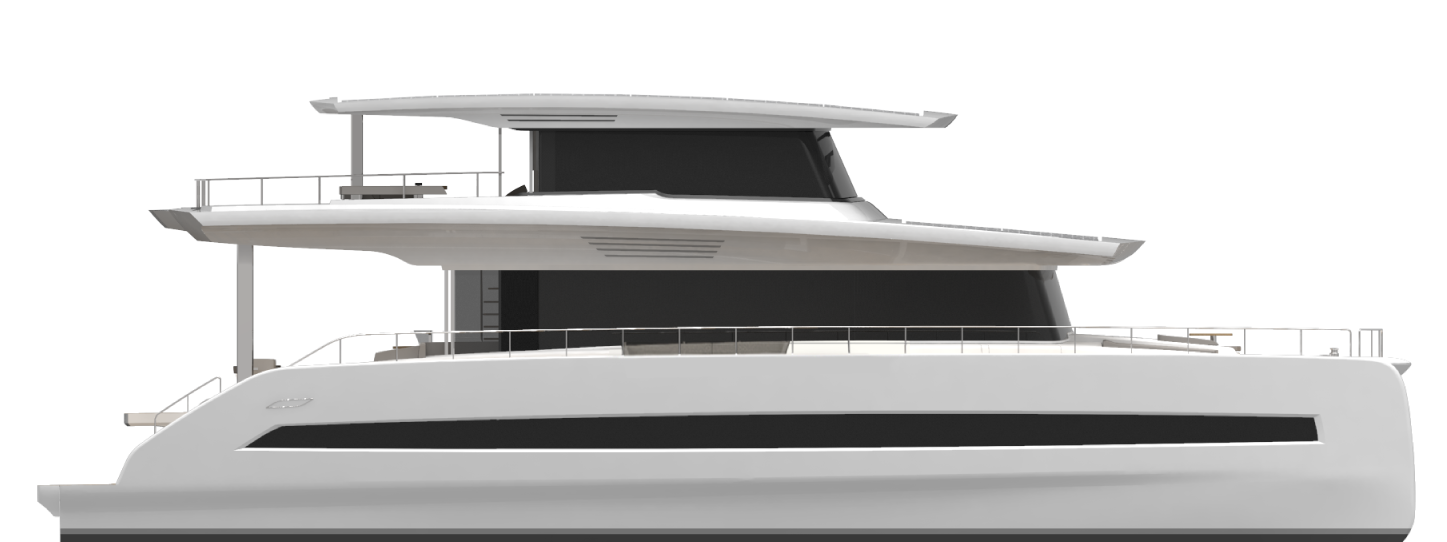
The closed 3-deck version features an owner’s suite with a private 41 m² aft terrace. Those who value sharing their experiences on board can opt for an indoor lounge instead. It is comprised of a 39 m² dining area, fully equipped with a bar and galley, while still maintaining the same terrace in the aft.
Silent 8O Flybridge
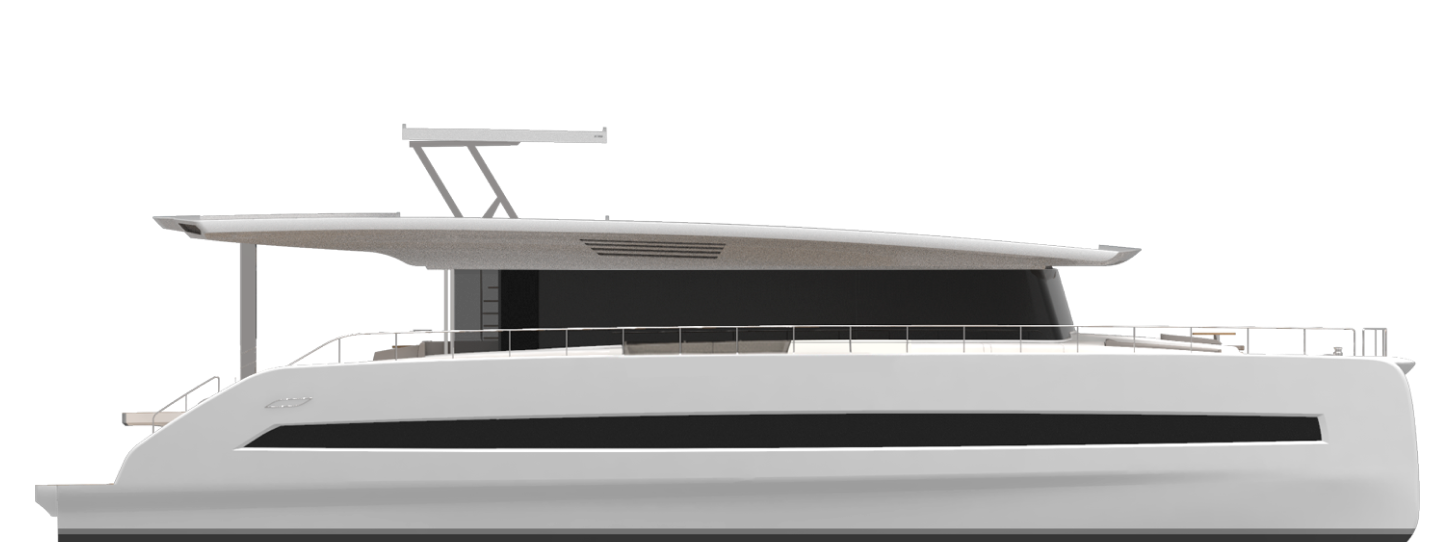
Just as the 60 Series, the 80 Series can also be configured with a retractable flybridge. With 53 m² of space, the flybridge version already offers plenty of room and is equipped with a dedicated helm station to steer the yacht while enjoying the 360° view.
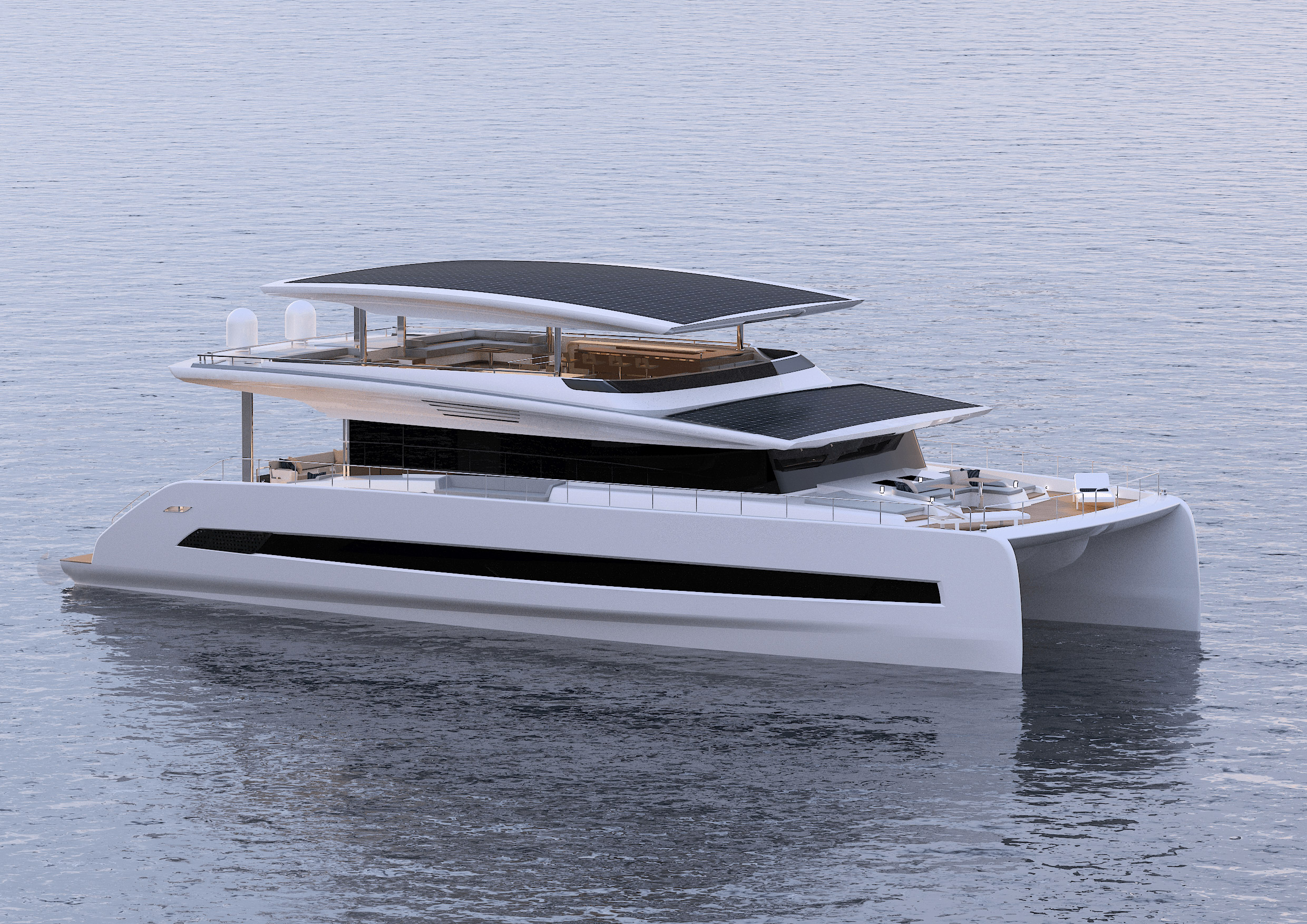
3-Deck Open
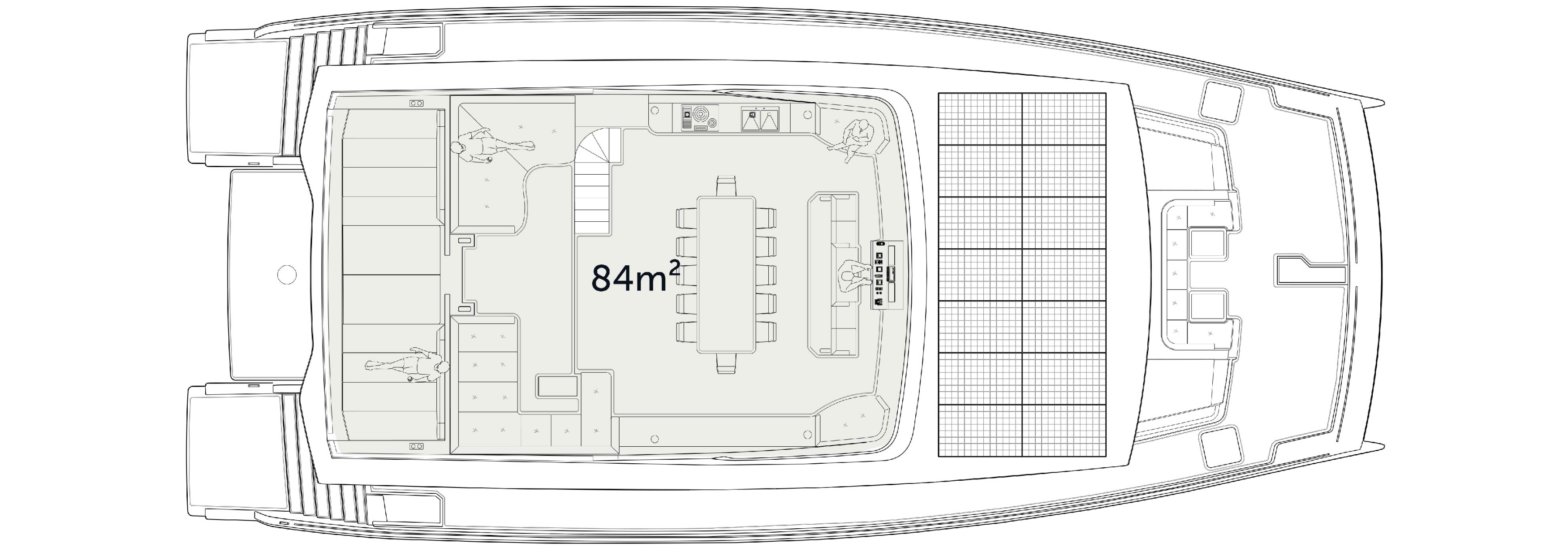
3-Deck Closed
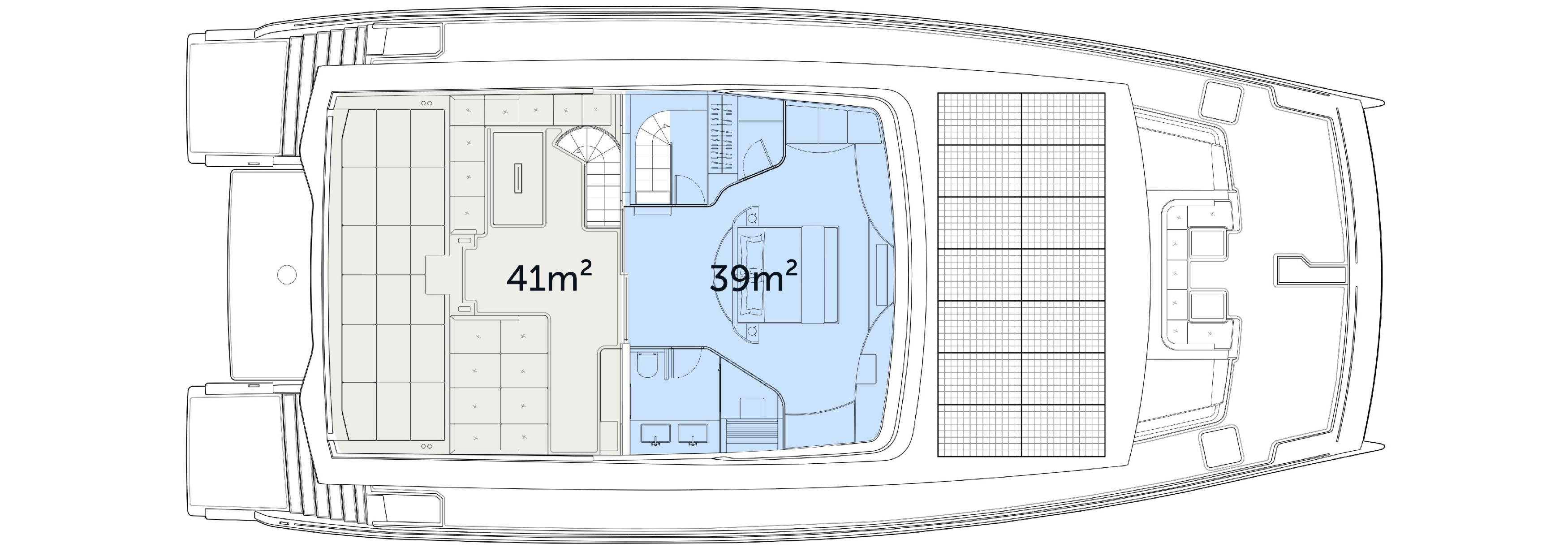
Version 1 (4+2 Cabins)
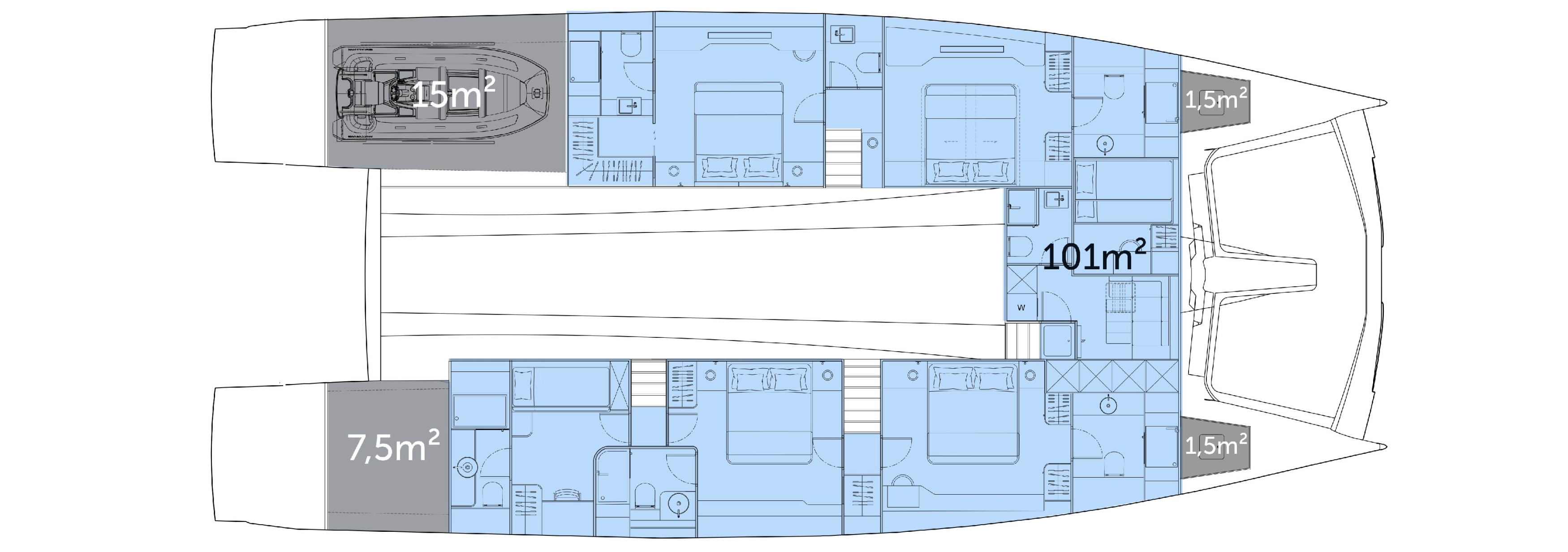
Version 2 (4+2 Cabins)
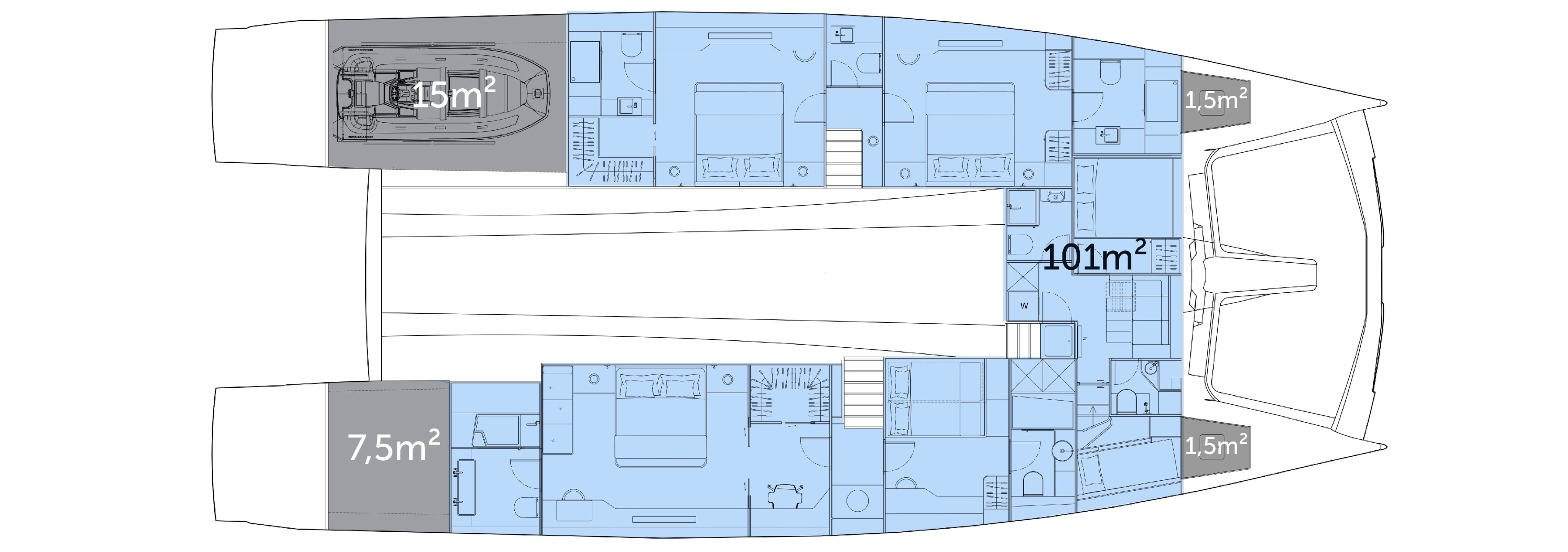
Solar-electric yachting advantages
Unlimited range, noiseless cruising, zero emission, minimal maintenance, powertrains, 8o series highlights.
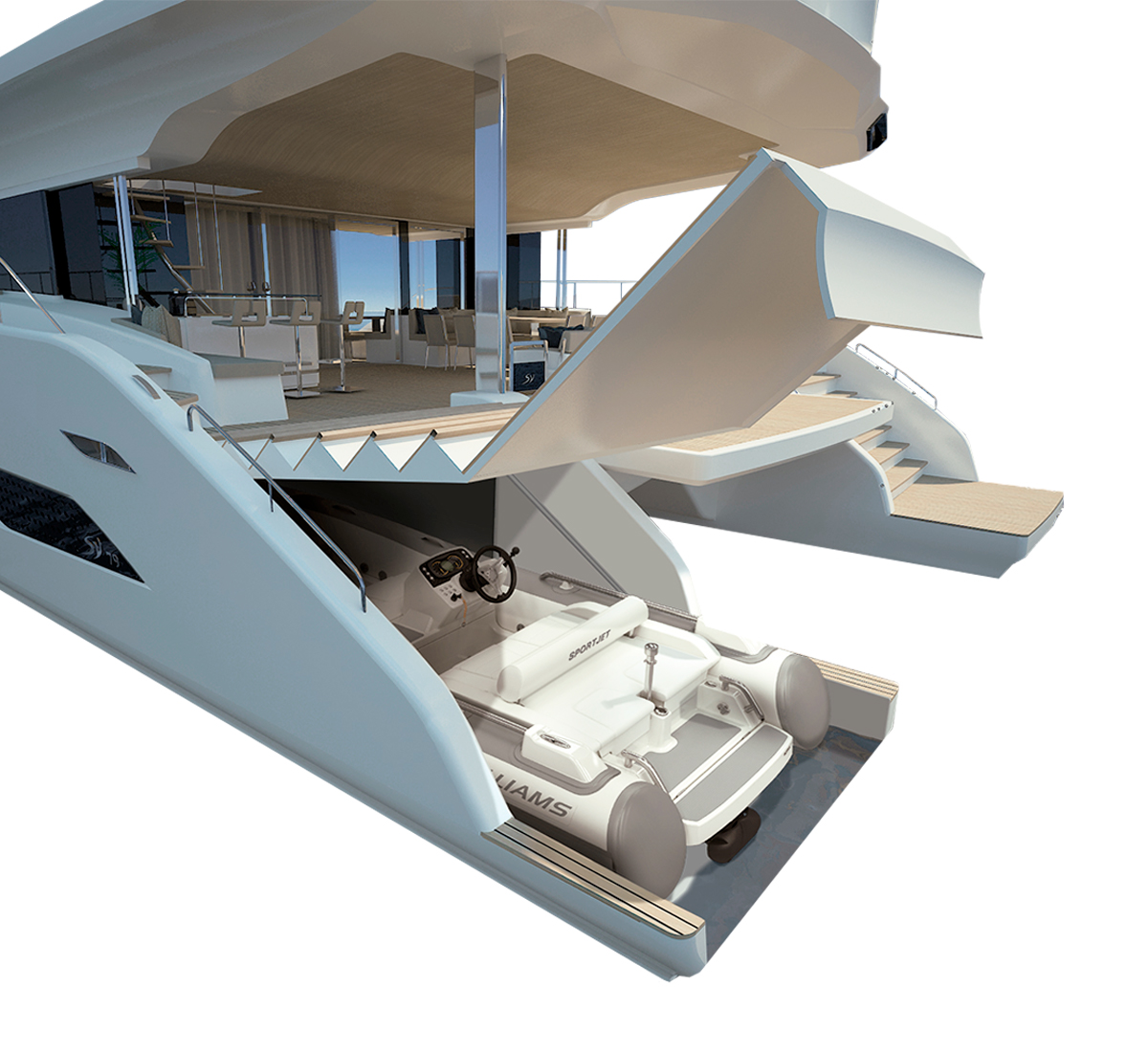
Tender garage
In the aft of the portside hull, the staircase can be raised to reveal a fully enclosed tender garage. It fits tenders with a maximum length of up to 5.20 m, such as the Silent Tender 520, and has a direct charging point to recharge electric tenders with energy produced by the yacht.
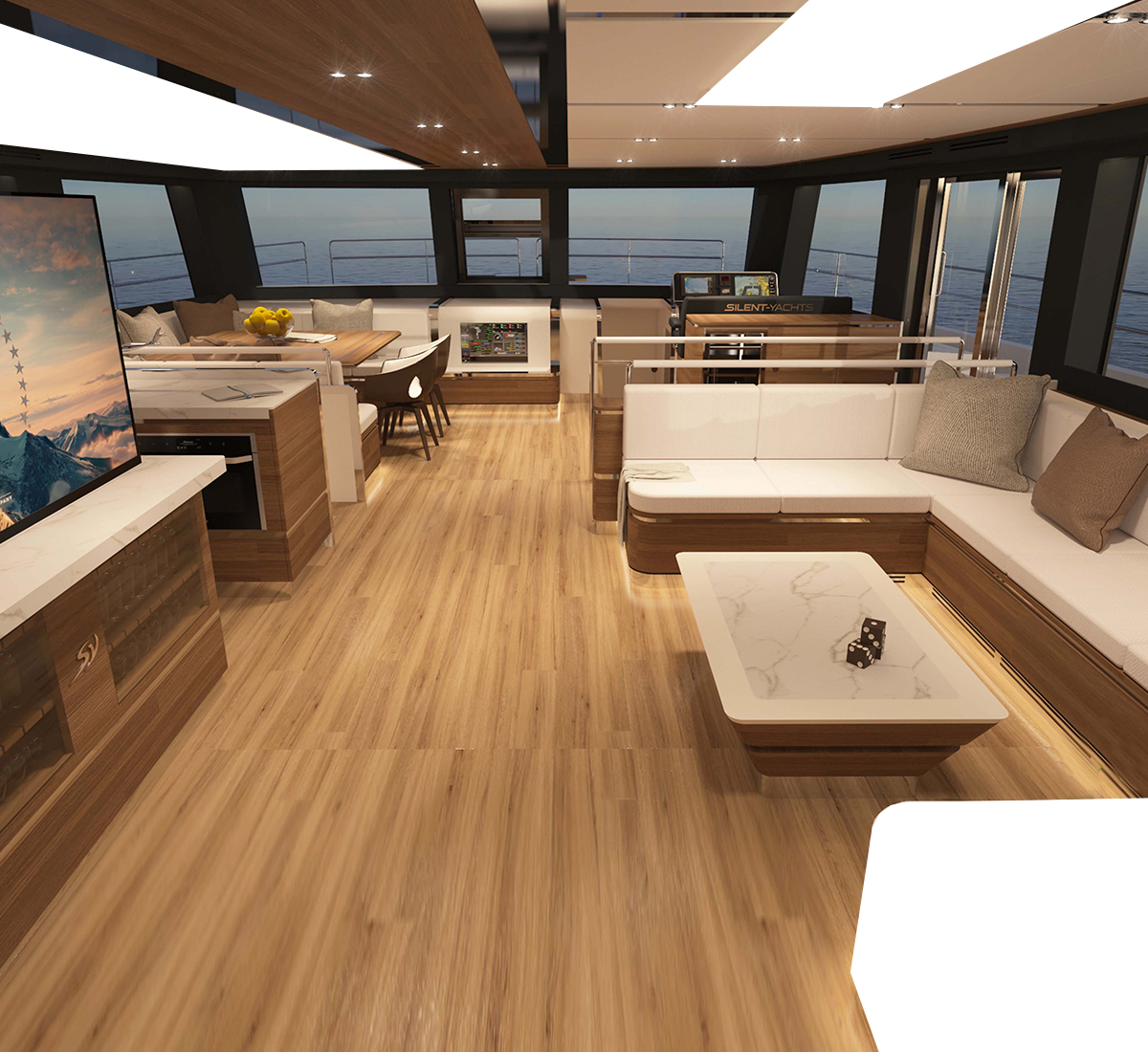
Largest salon area
When compared to other catamarans of similar size, the 52 m² salon of the 80 Series leads with the largest amount of interior space. This creates a lounge like ambiance which offers all the necessities such as a fully equipped galley to enjoy your stay on board.
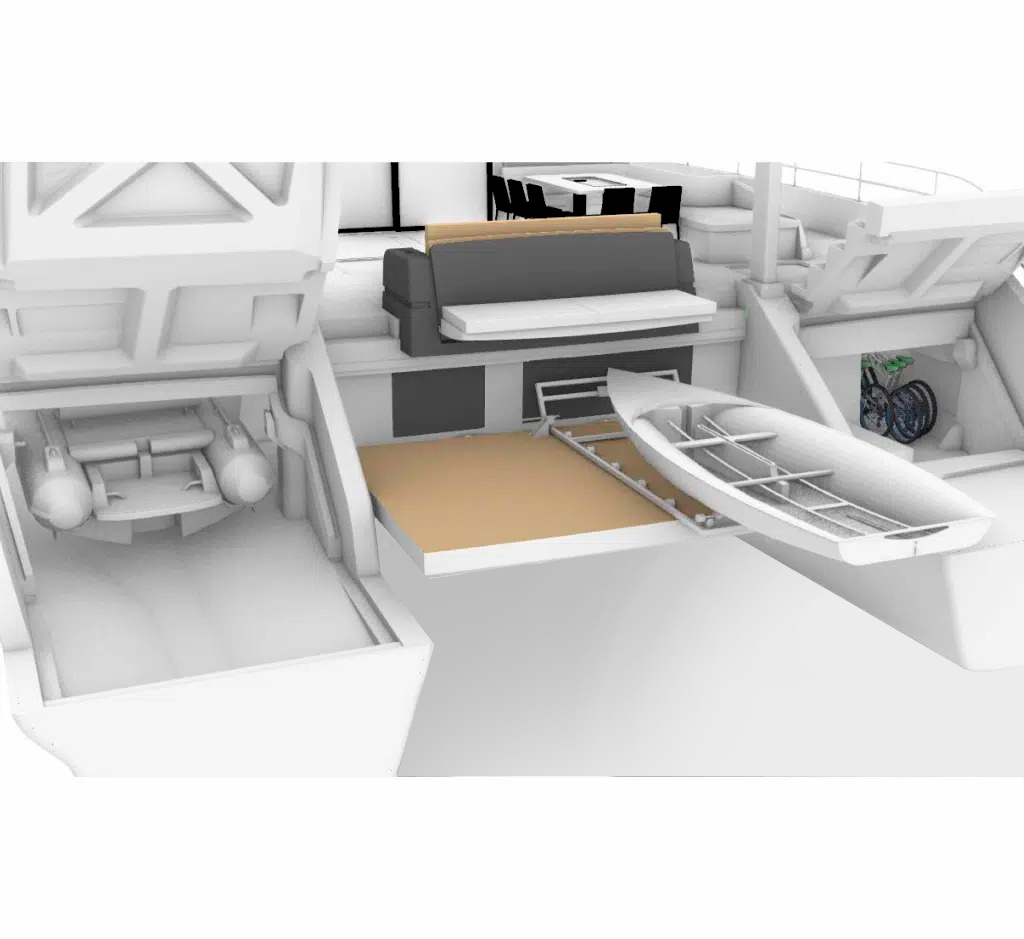
Aft storages
Inside the bridgedeck there is a large storage for water toys. Additionally, in the starboard side there is another storage compartment for diving gear, bicycles and motorbikes which can be accessed through hydraulically liftable stairs from the aft.
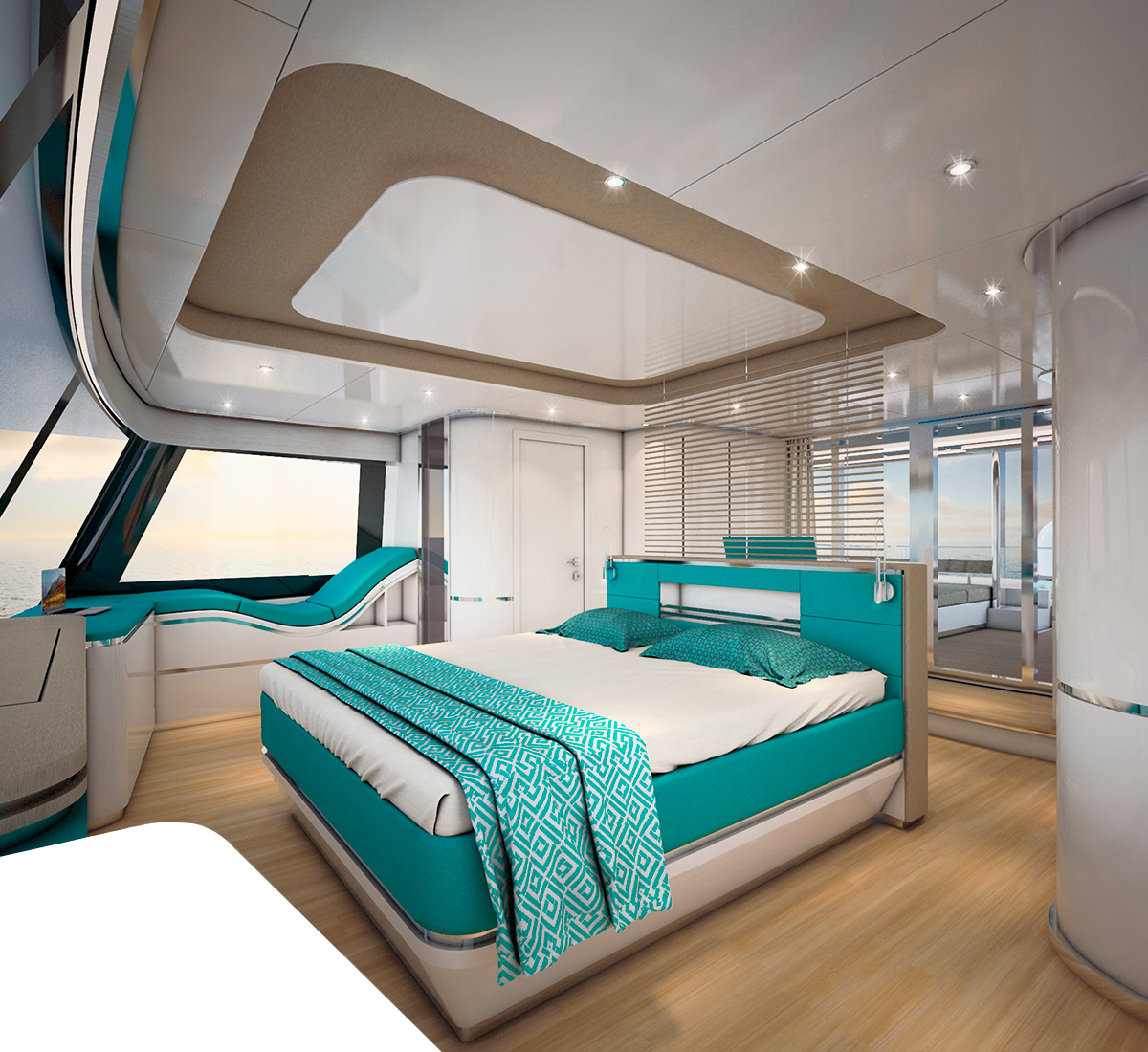
Owner'suite
The choice of an owner’s suite on the 3rd deck adds to the exclusive appeal of the Silent 80. With the entire deck measuring 80 m², it comes with an en-suite bathroom and a private terrace in the aft offering direct access to the sunbed.
8 Years Warranty Battery Banks
4 0 years warranty solar panels, lifetime warranty electric motors, ce-a category certification, ocean crossing capabilities.
If you would like to enquire about this electric yacht and get in touch with a member of our team, please click on the button below.
Other models
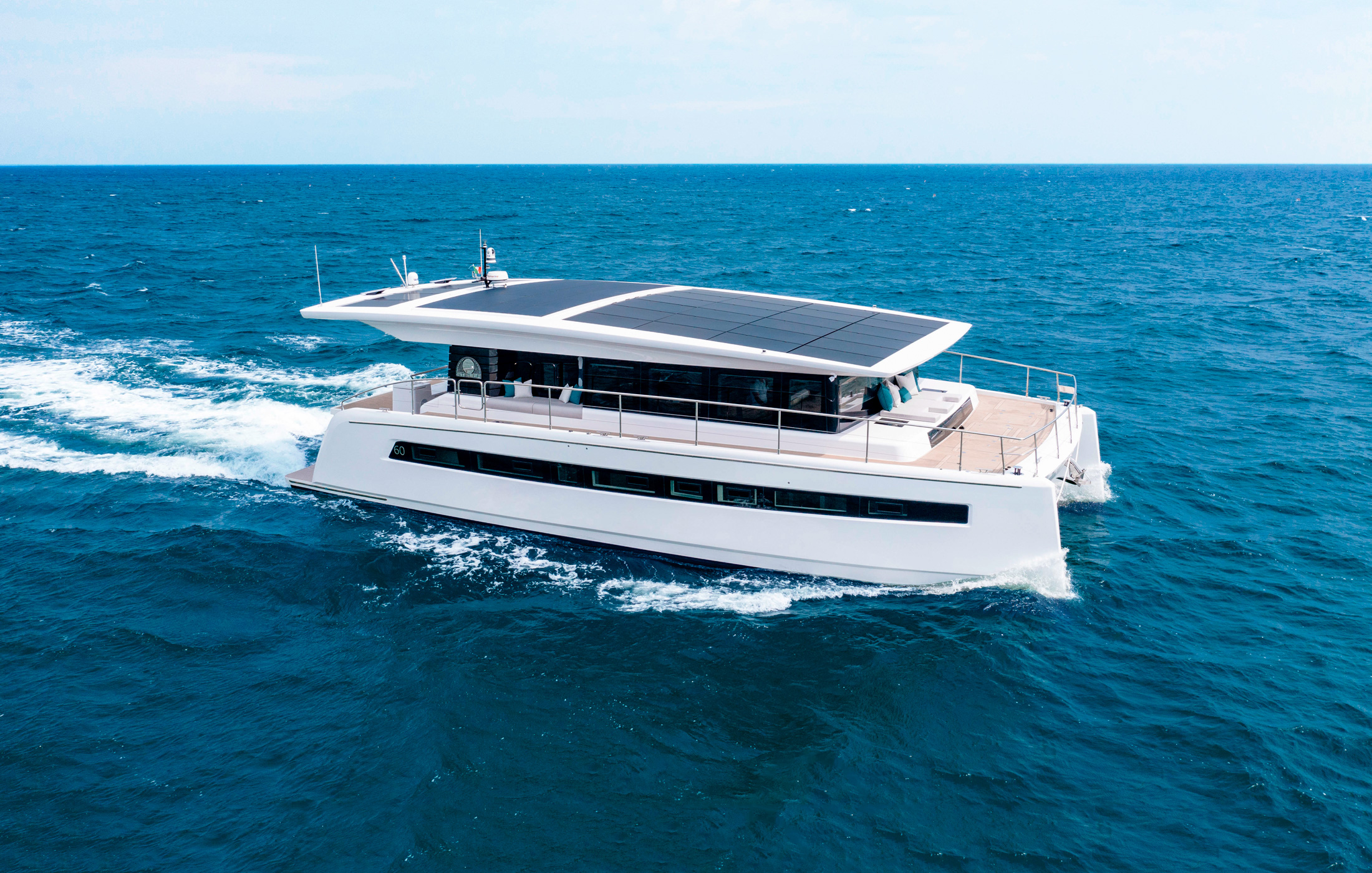
120 Explorer
Silent Group
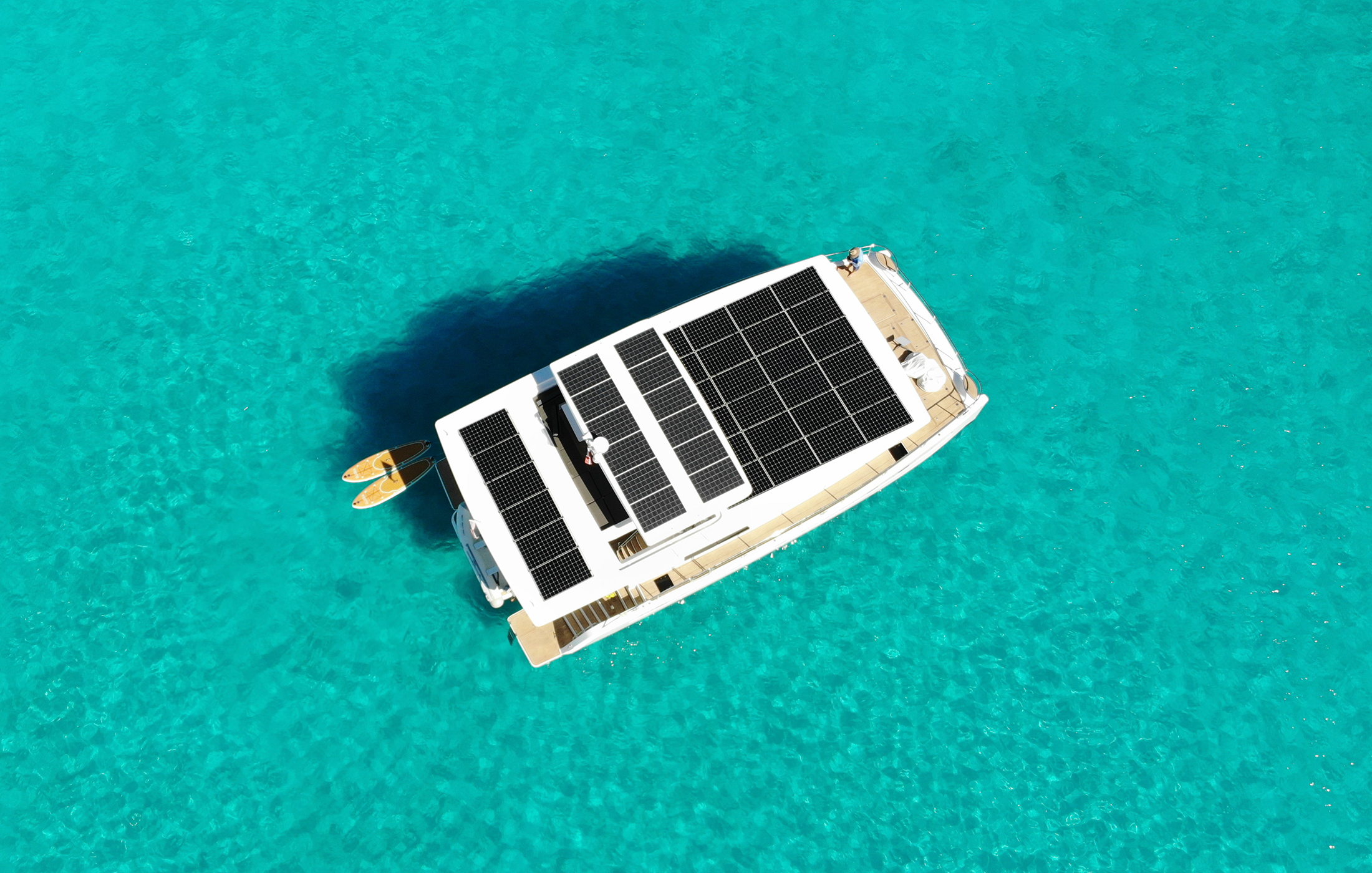
Our charters offer you the opportunity to book a memorable vacation on board of our electric yachts. Including our helpful crew, consisting of a captain and a chef, you will experience the comfort of solar powered yachting.
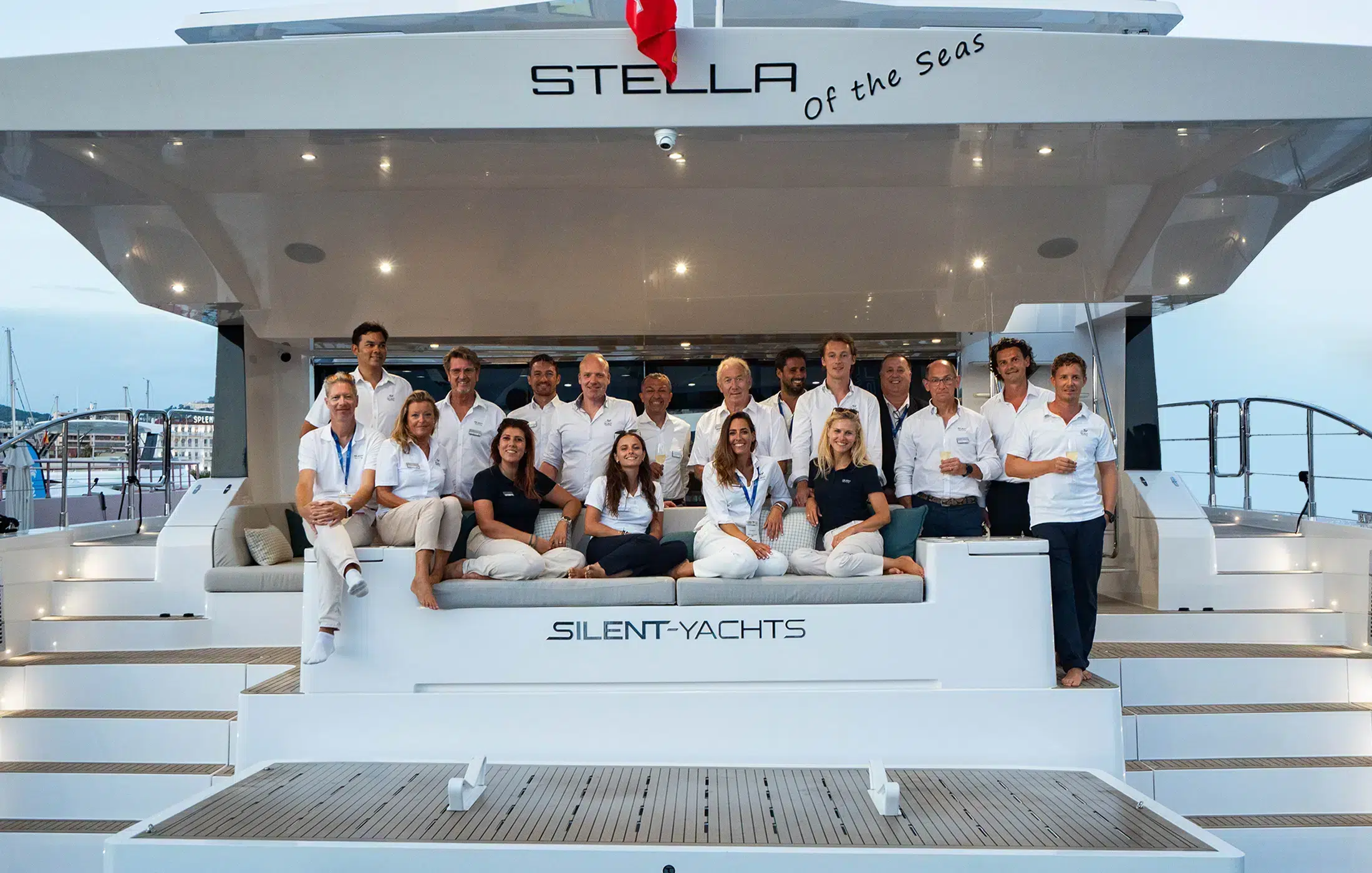
As the pioneers of solar yachting, we have almost three decades of experience regarding the research, design and build of electric yachts. Our team, shipyard and the hiring of new talent are the backbone of our operations.
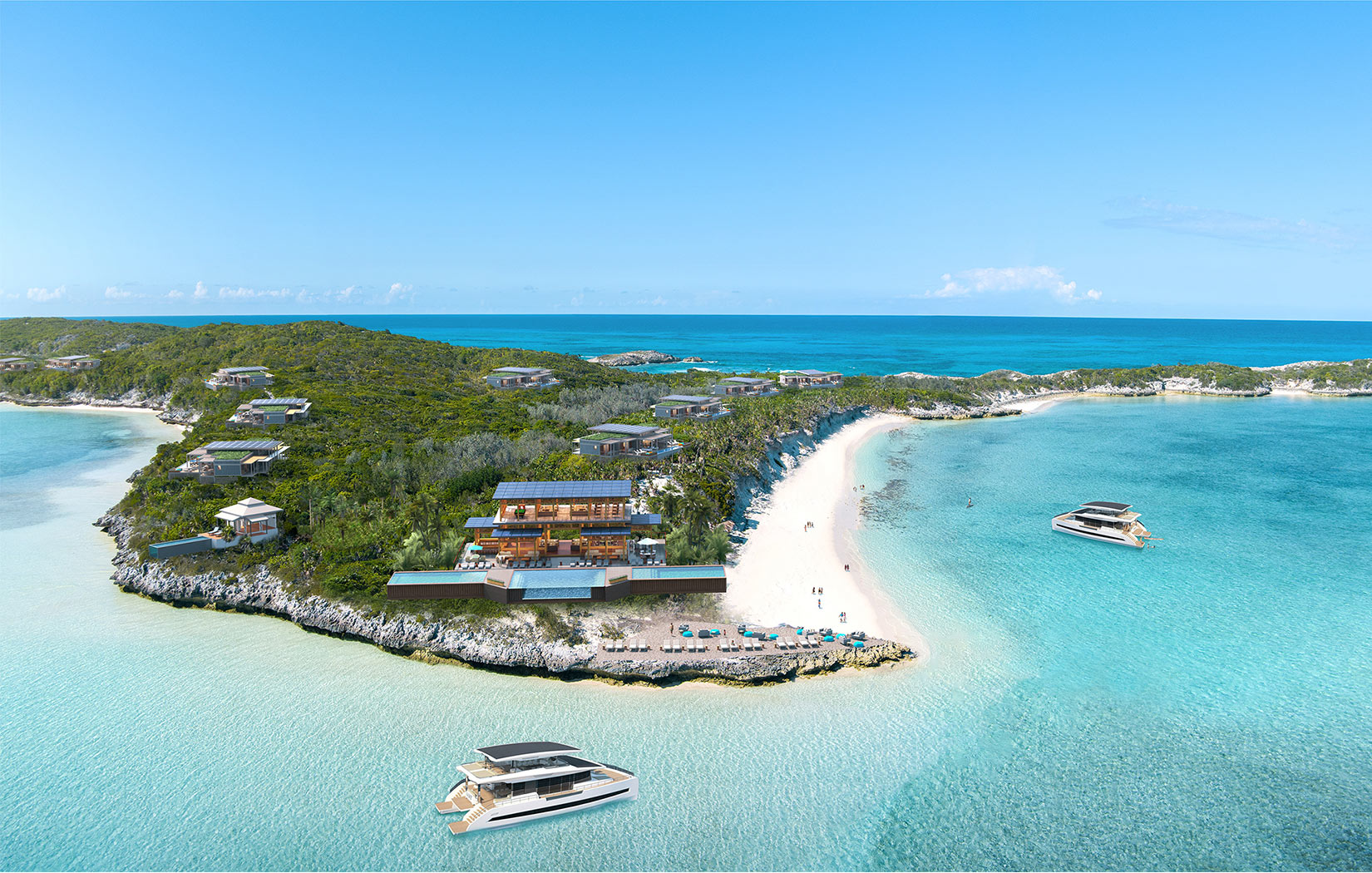
By transferring our solar yachting technology, Silent Resorts develops sustainable beachfront resorts in beautiful locations worldwide. Memberships offer full or part ownership of an eco-property and a Silent yacht.
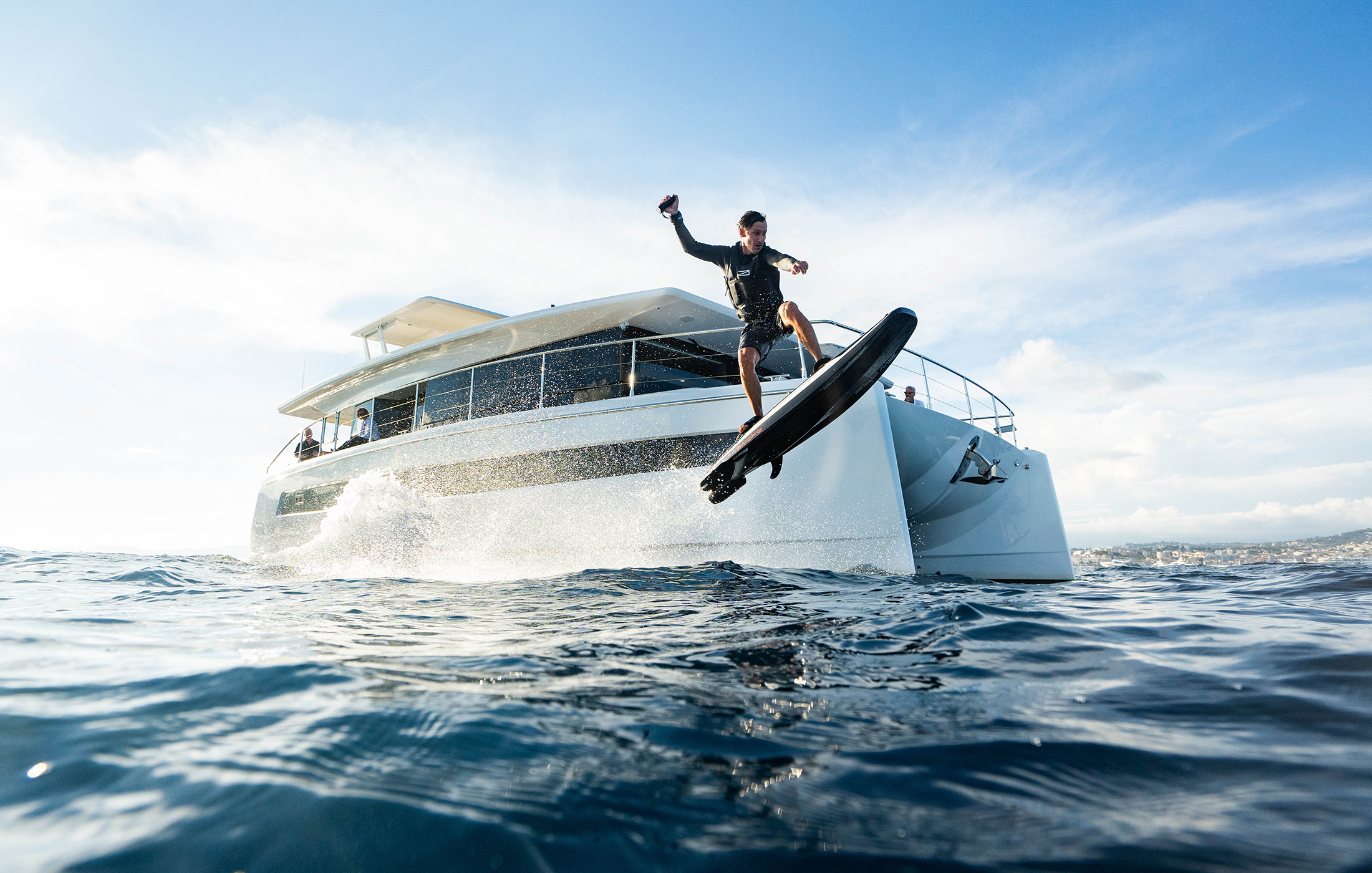
Create your infinite playground on the water. A selection of premium electric water toys, which can be recharged by simply connecting them to your Silent yacht, as well as other accessories for the ultimate experience on board.

The Best Solar Powered Catamarans (2023 UPDATE)
As an Amazon Associate, we earn from qualifying purchases. We may also earn commissions if you purchase products from other retailers after clicking on a link from our site.
Catamarans are incredible boats, and making one solar-powered really makes my little engineering brain go wild. In this article, I discuss some of the coolest solar-powered catamarans out there!
Here are three of the best solar-powered catamarans:
- Sunreef’s 80 Sunreef Power Eco Yacht
- Silent Yachts’ Silent 80
- Soel’s Senses 48
There are soo many variables that it’s tough to say one is better than the others. No matter which you board, you’re going to have a luxury experience. The benefit of these solar cats is that the experience can be had while maintaining a sustainable lifestyle and contributing to the betterment of the environment.
The diesel engine is dead, Long live electric power. Sort of…
Table of Contents
Solar Catamarans: Luxury Yachts
Before we look at each of these, let’s take a few paragraphs to talk about catamarans in general. First of all, when many people think of cats, they think of a relatively small craft barrelling across the water, one of its hulls in the air with a swashbuckling daredevil hanging off the side of it high above the water.
That’s not the kind of catamaran we’re talking about here. We are, instead, looking at yachts or cruising catamarans. These share one commonality with the other type of cat, and that’s the twin hulls. But that’s it. Cruising cats are slower, more stately boats. Also, on one of those little, quick ones, there’s not room for much of anything, and you won’t likely be doing any cooking or sleeping on it.
We’re also looking solely at solar-powered catamarans here, and although they have much in common with their diesel-drinking brethren, there are some key differences, which we’ll also address.
Perhaps the main difference (and one of the most significant selling points for a solar-powered catamaran) is the noise level. Gabo
Anyone who’s been on any boat with a combustion engine (diesel or petrol) on board has had to deal with the noise and smell.
But the drone (or roar, depending on the engine’s size and location) can be far from relaxing, which is one of the main reasons to get on a boat, off the mainland, and out to sea. Even if you’re marlin fishing—not the most peaceful undertaking man has ever attempted—you’re still out on the water and hope for some peace and quiet.
Eliminating that engine noise is a pretty big deal.
How Solar Catamarans Work
The biggest key to the success of the solar-powered yacht is not the solar panels – although those are great, as they look terrific and are well integrated into the ships. But the unsung hero here is the battery system.
Solar energy companies continue to perfect their industry. By making their solar batteries denser and denser, they create batteries that can store more solar power for more extended periods in smaller spaces.
And that brings us to an aspect you probably haven’t thought of:
Solar-powered yachts have more interior room because the battery system takes up less space than a conventional engine would.
Space customarily used by an engine room gets freed up for other uses.
Since most solar catamarans are nearly infinitely customizable, it’s hard to say what you might use that extra space for, but it’s available because of the solar power system.
The yachts have solar cells in all sorts of places, most notably on the roofs of the boats, but some companies build them in over large swaths of the hull, so they look as much like a design choice as a power source.
3 Best Solar-Powered Catamarans
Let’s be honest—if you’re dropping more than a couple of million dollars on a boat, two things are likely true: you have a lot of money, and you like nice things. All of the yachts listed here are lovely things, so it’s going to be hard to go wrong.
As a result (and since these aren’t exactly accessible for test drives), it’s difficult to say which one of these is actually the best ; ergo, this list is in no particular order. They’re all glorious specimens.
Incidentally, where the price is listed, that number is an extremely general estimate. As these vessels are all entirely customizable and each choice below is available in different lengths and configurations, the cost can vary wildly.
To better understand what is a good price of a solar-powered cat, they should be compared to performance cruising catamarans or larger catamarans for families .
80 Sunreef Power Eco Yacht
This may be the most remarkable boat you’ll see for a long time. Sunreef has been in the yacht-building business since the turn of the millennium, winning awards along the way, and in the last few years, the company began work on its Eco line.
While there are shorter (and one longer) versions of this ship, the 80-footer (24.38 m) is pretty iconic. It offers electric motors to push it over the water and to do so with little noise, vibrations, and zero smell of fuel or exhaust.
As mentioned earlier, this is the yacht with solar cells pretty much all over it. They dot the sides of the hull and add to the overall look of the ship. With these cells and the panels on the roof, this yacht carries 200 square meters (2152 sq ft) of solar cells generating up to 40kWp (that’s 40 kilowatts peak, meaning under the best conditions, like on a bright, sunny day). Sunreef makes cats that run under sail, as well.
- Unlimited cruising
- No emissions
- Silent running
- Solar panels on the sides of the boat may not appeal to everyone
- Price: $8 million USD and up (new)
Silent Yachts has several versions of each of its catamarans. This eighty-footer (24m) is available in a loft or a classic version, but you get large spaces and incredible luxury no matter what you choose. The bathrooms alone on these things are pretty enough to live in.
Like Sunreef, Silent Yachts offers various lengths of these yachts, but they refer to the 80 as their flagship, and with good reason. Also with good reason, this yacht has been called “the Tesla of the seas.”
Three power options exist, each allowing higher maximum speeds for longer periods on the water than the last, but all three offer cruising speeds of up to 8 knots.
Its rooftop solar panels generate 26kWp of power . While that’s a significant step down from the comparable Sunreef vessel, the company claims unlimited range. Theoretically, it makes sense—solar power is even easier to come by on the open sea than on land, and with an endless supply, you ought to be able to cruise forever (as long as the sun shines).
All that power gets stored in batteries, and when it’s time to use it, the boat does so silently through its electric motors, on which Silent Yachts gives a lifetime warranty. While that warranty wouldn’t give you much peace of mind if you were on the float hoping for rescue, once you got it back home, whatever the problem was would get fixed, and you’d be ready to go out again.
Like any electric motor propulsion system, the Silent 80’s requires almost zero maintenance. Compare that to the ongoing work you do on your big, loud, smelly diesel engine. Not having to change the oil alone seems worth the investment.
- Recommended maintenance schedule happens after the end of most yachts’ lifespans, meaning you may not ever have to do any maintenance at all on this one.
- Kite available for additional propulsion (up to ten times more efficient than a sail)
- Its five-and-a-half-foot draft is pretty deep.
- Smaller kWp capacity than comparable makes.
- Price: $4.6 million and up (new).
Soel Senses 48
This is a smaller yacht (a little more than half the size) than the first two. However, Soel has built a beautiful boat that is entirely sustainably powered. The 12 solar panels on the roof generate 2.7 kWp of electricity stored in two batteries that can be configured to hold up to 142 kWh of stored solar power.
This, like the others, makes for a boat that glides over the water without rattles, without fumes, without noise. Unlike the others, its cruising speed tops out at 10 knots —faster due to its smaller size. Its top speed runs at 18 knots, but with significantly less kWp on board, the ship won’t run at that top speed for extended periods.
The company lists the ship’s range at between 30 and 56 nautical miles (55 – 103 km) , and the fluctuation will come from various options and choices available in operational modes.
- The boat’s 2.3-foot (70.10 cm) draft is shallower than the larger boats here.
- Orders of magnitude more affordable.
- This is a smaller boat and won’t comfortably sleep much more than 10.
- Limited range means this is a weekend cruiser, not a circumnavigator.
- Price: $600,000 and up (new).
Other Choices
These next couple of catamarans are newer and smaller, but they bear mentioning for various reasons, which we’ll be sure to point out with each one. Again, at a certain point, a yacht is a yacht, and if you can fit your friends and family on it for a fun trip, everything else is just gravy.
Smaller than Silent Yacht’s Silent 80, this one is a product not only of Silent Yacht but one made in conjunction with Volkwagen and Cupra, a Spanish car company.
Volkswagen has become a significant player in the electric motor game, so the company brings its Modular Electric Drive (MED) to this vessel, allowing for an even more efficient electric propulsion system than the one on the Silent 80.
Cupra’s presence in the project seems to be solely on the design side of things. The Silent 50 is a vessel built with an eye toward a world in which water travel creates zero greenhouse gas emissions.
Aquanima 40
Azura Marine , based in Singapore, recently announced a solar-powered yacht whose biggest feature may have been its six-figure cost. According to Azura Marine, the ship can cruise indefinitely with a 10 kW solar power system and a 60 kWh battery pack. That is a smaller battery pack than the others, but it’s also a smaller craft.
This cat is a terrific combination of price and features.
Choosing the Best Solar Catamaran for You
This will be a personal choice and one you’ll want to do a lot of research on (which is presumably why you landed on this page in the first place). Since solar-powered catamarans sell for sums of money with at least seven digits in them, this will not be an impulse purchase for very many people.
Any of the choices listed here will be well-built, beautiful, luxurious places to lay your head or sip your mimosas while you’re on the water. It may come down to aesthetics, range, or speed, but all of these models offer incredible specimens that everyone—landlubber or old salt—will treasure.
The luxury yacht world is an exclusive one, but it doesn’t have to be wasteful or ecologically irresponsible. The yachts listed here are some of the best in the world in terms of combining luxury with solar power and providing emissions-free yachting that’s quiet and relaxing.
New yachts can be purchased from the manufacturers, allowing for customization, and various online yacht brokers are willing to help you find a pre-owned craft that’s right for you.
Finding the right yacht for you will depend on your wants and needs, but we can all agree that environmentally sound, sustainable power on these vessels is valuable.
- Electrek: This $500,000 electric yacht can cross oceans on just battery and solar power
- Forbes: Volkswagen Unveils 50-Foot Solar-Powered Catamaran In Partnership With Silent-Yachts
- Kite Boat Systems: Kite controller for sailing boats
- Plugboats: New 48′ solar electric catamaran from Soel Yachts
- Robb Report: Solar-Powered Yachts Are Taking Over. Here’s Why That’s a Good Thing.
- Silent Yachts: Silent 80
- Soel: Soel Senses 48
- Sunreef: 80 Sunreef Power Eco
Owner of CatamaranFreedom.com. A minimalist that has lived in a caravan in Sweden, 35ft Monohull in the Bahamas, and right now in his self-built Van. He just started the next adventure, to circumnavigate the world on a Catamaran!
Leave a Reply Cancel reply
Your email address will not be published. Required fields are marked *
Save my name and email in this browser for the next time I comment.
Recent Posts
Must-Have Boat Gear for Catamaran Sailors!
Sailing is probably the most gear-intensive activity I've ever done; there are so many decisions to be made about what gear to buy now, for tomorrow, and what to definitely never buy. The gear on...
6 Best Trailerable Trimarans For Bluewater and Coastal Sailing
Having a boat costs a lot of money, even when you are not using it, marina fees, etc. And once it is in the water most sailors never go very far from their "home marina" and sailing will be somewhat...
- Motorcycles
- Car of the Month
- Destinations
- Men’s Fashion
- Watch Collector
- Art & Collectibles
- Vacation Homes
- Celebrity Homes
- New Construction
- Home Design
- Electronics
- Fine Dining
- Baja Bay Club
- Costa Palmas
- Fairmont Doha
- Four Seasons Private Residences Dominican Republic at Tropicalia
- Reynolds Lake Oconee
- Scott Dunn Travel
- Wilson Audio
- 672 Wine Club
- Sports & Leisure
- Health & Wellness
- Best of the Best
- The Ultimate Gift Guide
How Zero-Emission, Solar-Powered Yachts Entered Boating’s Mainstream
Yacht builders are designing zero-emissions yachts to compete with diesel-chugging rivals. they're so quiet you can hear dolphins swim by., shaun tolson, shaun tolson's most recent stories.
- The 25 Best US Golf Courses That You Can Actually Play Now
- Fore! The 5 Best Golf Simulators to Perfect Your Game at Home
- Justin Thomas on Defending His PGA Title, Golfing With Michael Jordan and His Legendary Man Cave
- Share This Article

For many years, yacht builders adding solar panels to their boats discovered those panels would typically power a few things like the electricity and galley, and if they helped with propulsion, it would only carry a boat so far. In the last few years, new companies and boat-builders have emerged that are proving solar can be the main source of power—a big deal considering that most yachts are solitary creatures that are entirely reliant on a specific form of propulsion. No boaters wants to be 50 miles away from civilization in a turbulent ocean and suddenly see their engines go out. It’s not like they can call AAA.
Related Stories
- BMW Unveils Its Newest All-Electric SUV Concept
- Watch: NBA Star Luka Doncic Actually Drives His Apocalypse Hellfire 6×6 to Work
- Meet Spear, an Epic 460-Foot Trimaran Concept Designed to Slice Through the Seas
The problem was that most yacht builders were sticking panels into yachts that were never designed to be self-sustaining. Boyd Taylor realized that several years ago as he was conceptualizing solar-powered catamarans for his company Serenity Yachts . Near the end of 2019, Taylor oversaw the launch of the Serenity 74, with almost 1,200-square-feet of solar panels. Those panels support all of the yacht’s onboard functions, while it cruises at 9 to 11 mph indefinitely.
The yacht functions so capably—using only solar power—because Boyd and his team of engineers started from the water up. They created an electrical system designed to only use solar energy. “We started with the solar system and built the rest of the boat around it,” Boyd told Robb Report.

Soel Yachts is one of the latest builders to introduce a solar-powered catamaran for emissions-free cruising. Courtesy Soel Yachts
Once the electrical system was in place, Serenity Yachts ’ team of naval architects and engineers designed a lightweight boat made of carbon-fiber weave, not pure fiberglass. Taylor says a fiberglass boat that size would weigh 8 tons more. Despite that emphasis on lightweight design, a Serenity Yacht still features interior accents and design materials that mean luxury. Granite countertops, for example, are built around a honeycomb structure, so only a thin layer of granite is needed.
Other boatbuilders have gained traction in the marketplace, as well. Soel Yachts , a Dutch company founded in 2011, recently launched its Soel Senses 48, a 48-foot pleasure craft that can sail at a top speed of 21 mph and cruise up to 56 nautical miles at 14 mph. Like Serenity, the Soel Senses 48 was designed for “high-efficiency electric propulsion,” as the company states—in other words, it was designed from the very beginning with solar power in mind.
Silent Yachts is one of the leaders in the solar-powered yachts industry, having just launched an 80-foot tri-deck catamaran that is powered by more than 1,200 square feet of solar panels.

Serenity’s 74-footer makes use of the catamaran’s wide beam, while adding windows across the entire upper salon. Courtesy Serenity Yachts
In September, BYD Group , a full-service naval architecture and engineering firm in Spain, unveiled a new all-electric, self-sufficient 65-foot coastal cruiser dubbed Eegle. Positioned as a “game changer in the world of eco-friendly motoryachts,” the Eegle is equipped with 323-square feet of solar panels on its hardtop. Those panels, combined with four, 150-kilowatt electric engines, allows the yacht to cruise 1,080 nautical miles at 8 mph.
“Today, solar panels are much more advanced and can be adapted to more surface shapes than in the past, giving us more freedom to install solar panels in more areas,” says Tià Simó, a co-founder of BYD Group.
Beyond offering clean, eco-friendly sustainability, the benefits that an exclusively solar-powered yacht can offer, according to Taylor, are what your senses don’t pick up while on board.

BYD’s master suite shows the design advances that have been made in the last year in solar yachting. Courtesy BYD Yachts
“You’re running a silent boat,” he says. “You don’t have the smell of diesel fumes or the vibrations and rumblings of a diesel engine. You get to smell the salty air and hear the waves slap against the hull of the boat. You can actually hear dolphins splashing in the water. You not only get to enjoy this incredible scenery and enjoy nature in all of its majesty, you get to know that you’re leaving it the way it was when you came.”
Read More On:
- Serenity Yachts
- Silent Yachts
More Marine

This New 131-Foot Aluminum Catamaran Concept Can Take on a Transoceanic Expedition

This New 150-Foot Superyacht Can Cruise Through Shallow Waters in Florida and the Bahamas With Ease

Open Space, Eco-Friendly Tech: What a Rising Class of Millennial Superyacht Owners Is Looking For

‘People Don’t Want to Be Inside’: How the Outdoors Became Yachtmakers’ Most Coveted Design Element

Culinary Masters 2024
MAY 17 - 19 Join us for extraordinary meals from the nation’s brightest culinary minds.
Give the Gift of Luxury
Latest Galleries in Marine

Palm Beach Vitruvius in Photos

The 10 Most-Exciting Yacht Debuts at the Palm Beach International Boat Show
More from our brands, skin care maker galderma’s shares fly on stock market debut, more than ‘caitlin clark effect’ driving women’s basketball boom, dave grohl debuts a bro love song he wrote for josh homme at l.a. benefit, with beck, st. vincent and bill burr among guest stars, australian museum faces lawsuit for artwork that men cannot enter, the best yoga blocks to support any practice, according to instructors.
Yachting Monthly
- Digital edition

Sailing with solar power: A practical guide
- Duncan Kent
- November 13, 2020
The latest solar technology makes self-sufficient cruising much more achievable. Duncan Kent gives the lowdown on everything you need to get your boat sorted

SOLAR POWER ON BOARD
Solar power is fast becoming the most popular and economic method of keeping the batteries charged on a boat.
Particularly now that the efficiency of photovoltaic (PV) panels, charge controllers and batteries is improving every day.
Furthermore, the latest technology in regulators and charge controllers has brought about a noticeable increase in useable power output, so the problems of shading and non-alignment can be compensated for more easily.
Not only has PV equipment become more efficient and cost-effective, but many of the modern devices we want to use on a boat have become less power hungry.
This means it is now far easier to provide your entire yacht’s electrical needs, both 220Vac and 12/24Vdc, from natural energy resources – particularly solar power, even if you are planning on a fully electric boat .

Thinking carefully about how much power you need and how much your boat can accommodate is key to planning a solar array. Credit: Graham Snook
WHAT DO YOU NEED?
For instance, a boat with two new, good quality, deep-cycle house batteries of 100Ah each would supply 100Ah of energy to consume between charges, if you only use the recommended 50% of available charge between each charge cycle to protect the batteries.
From this you could run:
- a modern 12Vdc fridge (approx. 1.5Ah, or 36Ah over 24hrs),
- all LED lighting (say 20Ah per day),
- various small device chargers (20Ah)
- and a number of other items such as water pumps, TVs and stereos (25Ah/day)
- Totalling around 100Ah.
- For this you’d need 400W of solar capacity.
Of course, if you like to run a lot of AC devices off-grid such as hair dryers, microwaves, toasters and the like, then you’re going to need a DC/ AC inverter, which will take you to another level in power consumption terms.
But even then, with careful planning, solar could provide a large portion of the power you need before resorting to engine charging or a generator.
THE AVAILABLE SPACE
In practical terms, a modern 40ft monohull would have the space for around 1,200W of PV panels (cockpit arch, sprayhood top, deck), maybe 1,500W with the addition of a few portable panels for use at anchor.
The 1,200W of fixed position solar array could produce around 360Ah on a sunny summer’s day (zero shading) or more likely 250Ah on the average UK summer’s day.
So that’s enough for your 100Ah general DC consumption plus another 150Ah of AC consumption via the inverter.
Of course, to do this you’ll most likely need to increase your battery capacity to around 400-500Ah for maximum flexibility (you’ll need to store as much as possible during daylight hours), a typical figure for a 40-50ft offshore cruising yacht these days.

Get your solar charging right and you may never need to hook up to shore power
Typical daily inverter loads for a cruising yacht off grid might be:
- induction cooking plate (20min) 60Ah
- microwave (15min) 30Ah
- coffee maker (20mins) 25Ah
- hair dryer (5min) 15Ah
- laptop charger (2h) 10Ah
- or around 140Ah in total.
The trick is to monitor the batteries’ state of charge (SOC) at all times and vary your use of the inverter to suit.
For example, you might want to cook supper mid-afternoon, when solar is in abundance, and then reheat it in the evening when you want to eat it.
In some cases, when you’re cruising in warm climates such as the Med, you might end up with excess charge from your solar panels .
In this situation, many long-term cruisers devise a method of ‘dumping’ the extra energy by heating water for showers.
Do bear in mind if you’re planning to live aboard full time , then it’ll be a whole different story on cloudy days and during the winter, when inverter use might need to be knocked on the head entirely.
Continues below…

Eco friendly sailing: Best practice for green yachting
How easy is it to go eco friendly sailing? We look at the steps cruisers can take to minimise their…

How and where to go wild cruising in the UK
Planning to spend the night away from crowded waters can be truly rewarding but preparation is essential before you go…

Solar-powered boat crosses Atlantic
Then heads to UN climate conference
POWER DISCREPANCIES
There’s often confusion as to how much power you can harvest from a solar installation.
A PV panel is nearly always advertised stating its theoretical peak output power (Pw).
But in reality, on a yacht where there are limited areas in which to mount them, they will more likely produce a maximum of 60% of their peak output if mounted horizontally, increasing to 80% if tilted towards the sun and regularly adjusted.
The latter is rarely achievable on a boat, however, as even at anchor it can swing through an arc of 180° in wind or tidal shifts .

Flexible panels can be mounted on sprayhoods or awnings to add power when it’s needed at anchor or in harbour
INSTALLATION
Having trawled through hundreds of ‘deals’ to get the best price on the most efficient panels you can afford you now need to know how to install them to best fulfill your energy generation needs.
The output, even from the highest quality photo-voltaic array, will only be as good as the installation itself.
So following our guidelines should ensure you extract every last drop of energy from your investment.
PANEL MOUNTING
Sailing boats are not the ideal structure on which to mount wide, flat PV panels.
So before you go ahead and purchase what looks like the biggest and best, take a few minutes to decide on exactly where you can mount them, as this will affect what size and type of panels you should buy.
In many cases the first choice would be on an arch, davits or gantry aft, especially if you already have, or plan to fit one.

Dinghy davits, particularly on multihulls, can support a huge solar capacity
These allow a solid metal framework to be constructed that will be strong enough to take the heavier, more productive rigid PV panels.
You can also build in some form of adjuster to the framework that will allow the panels to be orientated towards the sun for the best performance.
With luck (or careful planning) a gantry will also keep them aft of the boom, thereby eliminating loss of output caused by boom shading.
The next most popular position for mounting the panels is on a cockpit sprayhood or bimini, although this will often mean using the flexible or semi-flexible panels, which are generally less efficient than the rigid ones for the same area.
ELEVATED MOUNTING
Alternatively, there are kits available for mounting panels onto lifelines, which can allow their elevation to be manually adjusted to a certain degree.

Pole-mounted panels can be used for maximum adjustability
Finally, panels can be fitted directly onto the deck by either gluing them down using mastic or attaching them onto a rigid support frame.
Once again you will probably need to use semi-flexible panels – especially if the deck surface is curved.
Rigid, glass-coated panels will obviously not be suitable for deck mounting in an area that is frequently walked over.
Don’t be tempted to drill through the panels, even along the edges, as this will invalidate the warranty and possibly damage the panel.

With solid panels, the ability to adjust the angle can add significantly to output
It might seem obvious, but the key to an efficient system is to avoid shading wherever possible.
It’s no good fitting expensive, high-efficiency PVs right under the boom as they’ll perform little better than the cheaper types.
Saying that, in good quality panels each cell will be isolated from the next by a series of diodes (one-way electrical valves), so that if one cell is shaded at least it won’t drag down the other cells within the same panel.
Older panels often didn’t have these, so the slightest partial shading caused the output of the entire panel to cease.
OVERHEATING
Another important factor that is often ignored when installing the panels is that of overheating.
If a PV panel gets too hot, which is quite likely if mounted directly onto a flat surface without an air gap behind, its output will drop quite noticeably.
To allow for some air circulation behind the panels it’s best to apply mastic adhesive in numerous large dabs.
This is best achieved by placing wooden spacer strips between the dabs until the mastic has completely cured, after which the spacers can be removed.
You might need some form of trim around one or more of the outside edges, though, if they are positioned where sheets and other lines might get caught under them.
Raising the panels up will also help water to drain off and thereby helping to avoid possible delamination from sitting in water for too long.
CHARGE CONTROL
A PV module cannot supply an electrical device directly due to the changeability of the sunlight, which in turns varies the current it can produce.
Therefore, it has to be connected to a battery, which stores and smooths its output.
Whatever the size of your solar array you will need to fit a regulator, or charge controller as they are now more commonly known, to the system in order to control the output and to help extract as much power from the panels as possible.
There are two types of PV charge controller.
The older designs, called Pulse Width Modulation (PWM) types, were fairly basic voltage regulators and simply output volts at just above battery level.
The latest controllers use Multi Power Point Tracking (MPPT) technology and can accept much higher input voltages (up to 240Vdc).
MPPT controllers can be up to 30% more efficient as they use the peak output of the panels to charge the batteries, even compensating for partial shading.
BEWARE FAKE GEAR
If you buy online do be careful to ensure you’re getting what you pay for.
There are a huge number of fake MPPTs out there, which are simply the much cheaper PWM dressed up with fake labels.
It’s hard to tell which is which, but the old adage of ‘if it looks too good to be true, it usually is’ makes good sense.
MPPT controllers are usually bigger and heavier than PWMs, but if in doubt call or email the supplier to discuss the pros and cons of their kit before buying.
If they’re not happy to chat and advise you then I would steer clear of their gear.
Some good MPPTs are made in China, but unless they have a UK supplier, I wouldn’t bother with them as you’ll have no follow-up advice.
To calculate what size controller you need simply divide the panel’s peak power in Watts (Wp) by the battery voltage, which will give you the maximum current (Amps) they could theoretically supply.
For example 240W/12V = 20A. Although it’s unlikely you’ll ever get near the peak output from any PV panel, it’s best to go for the maximum possible.

Induction cooking is now a reality on board, even without shore power
PV panels come with a short length of cable, usually around 1m long.
Some are supplied with MC4 connectors already attached but most only provide bare wires.
The latter can be easily extended using proper waterproof connections but thought must be given as to the current rating and voltage drop (usually max 3%) for the size of cable you intend to use.
If in doubt, bigger is better!
Panels can sometimes be ordered with the wiring on the back so that the cable can go straight below deck through a hole under the panel.

You may need to fit extra battery capacity if you want to run an inverter from solar charging
SERIES OR PARALLEL?
A commonly asked question is ‘should I wire my PV panels in series or in parallel?’
The simple answer is, if there’s any danger of frequent shading to one or more of the panels then install them in parallel.
If wired in series the shading of a single panel will drag down the output from all of the others in the same series.
PARALLEL IS PREFERRED
Most commonly, multiple panels are wired together in parallel to a single charge controller, with diodes protecting each panel from discharging the others should one become partially shaded.
With the advent of MPPT controllers, however, there can sometimes be a benefit to wiring two or more identical panels into a series bank, thereby presenting a higher voltage to the controller.
It’s worth noting that, like batteries, wiring PV panels in series increases the voltage only – the current capacity of the array remains the same as for a single panel.
‘Where’s the benefit of wiring them in series then?’ you might ask.
Well, the higher the voltage fed into the MPPT, the more consistent it will be with its output, which could, in some cases, prove more efficient than a parallel installation with PWM controllers.
It’s also likely to be necessary if you have a 24V domestic system.
SERIES WIRING
Series wiring is usually only done when the cable runs are long, as it helps negate the voltage drop caused by the resistance of the cable.
While a decent controller will have no problem handling the output from four or even five panels wired in series, it is often inappropriate for sailing yachts as shading just one of the panels will reduce the output of the entire series array.
If you need to do so in order to reduce cable runs then it’s best to split the panels between each side of the boat – a series bank on each side.
If you do this, then you would ideally fit a separate controller to each series PV bank and then connect their outputs together in parallel to the battery bank.
Note, however, that panels wired in series must all be the same types with an equal number of cells per panel.
Furthermore, the charge controller needs to be sized for the total of all panel voltages added together and the current rating of one individual panel.
Differently rated panels can be connected together in parallel but only if each panel has its own controller.
The outputs of the individual controllers can then be joined together to go to the battery bank.
BATTERY BANK QUESTION
Another frequently asked question is ‘Can I connect another charging source to the battery bank while the solar array is charging?’
The answer is yes.
Any decent PV controller will be protected against feedback from other charging sources.

Think carefully about where shade from mast, boom and rigging will fall. Credit: Graham Snook Photography
CABLE SIZE AND CONNECTORS
A frequent cause of reduced output from PV arrays is wiring that is too small.
The resistance of a wire conductor increases in direct proportion to its cross-sectional area, so go as big as is practicable for the least cable loss.
Each panel should be supplied with the correctly sized cables for its own maximum output.
But if you’re combining panels, either in parallel or in series, you will clearly need to rate the single feed cable to suit the maximum current available at theoretical peak solar output and to minimise voltage drop.
Likewise, the cable from the controller to the batteries should be sized to suit the controller’s maximum output current and protected with a fuse.
For outside it’s important to use exterior grade cable, which is double- insulated and UV-proof.
WEATHERPROOF CONNECTORS
And wherever possible use compatible weatherproof connectors (usually MC4) to those found on the panels rather than cutting off the plugs and hard-wiring them.
Field- assembly MC4 plugs are available, so you don’t have to drill large holes in the decks or bulkheads when feeding the cables through.
When joining more than one panel together try to use the approved multiway connectors; not only do they keep the wiring neat and tidy, but they also offer a greater contact area than budget terminal blocks.
If you have to use screw-type connectors make sure to fit proper ferrules to the wire first to avoid any stray wires in the multistrand shorting across the terminals.
When feeding a cable from above to below deck, try to go through an upright bulkhead where possible to minimise ‘pooling’ of water around the access hole.
Also, use a proper watertight deck seal that matches the cable you’re using.
If drilling through a cored deck you need to drill a larger hole first, fill it with epoxy resin and then drill the required size hole through the epoxy to ensure no water gets into the deck core.
Ideally, the charge controller should be mounted no further than 2m from the battery bank.
If you need to go further, you’ll require larger cabling to reduce the voltage drop.

A generous solar array will keep you self- sufficient indefinitely. Credit: Graham Snook Photography
CONTROLLER LOAD TERMINALS
There is often confusion over the ‘load’ output of a charge controller (often depicted by a light bulb) and what can safely be connected to these terminals.
Rarely explained in the manual, the load terminals should be pretty much ignored in a marine installation as the output on these terminals is usually very limited (10A max).
Some attach an LED light to them to indicate the controller is operating, but all your usual electrical loads should remain connected to the batteries with the battery terminals on the controller connected directly to that battery bank via a fuse.
It is possible, though, to control a high-current switching relay in certain conditions.

Parallel installation is more resilient to shading, but a series installation will increase peak charging outputs. A combination of the two offers some of the benefit of both
CIRCUIT MONITORING
Unlike most cheap PWMs, the majority of good quality MPPT charge controllers come with an alphanumeric LCD screen to let you know what is going on.
This can either be a remote display or simply one on the front of the box.
It’s obviously a lot better to have a proper numerical display than to rely on a few flashing LEDs to tell you when something’s not right.
So if your chosen controller doesn’t have one be sure to fit a battery monitor (the shunt type) into your solar circuit between the controller and the batteries.
It doesn’t have to be a very ‘smart’ monitor, just one that can display the voltage and current being supplied by the panels.
For smartphone addicts there are several wifi apps that will do the job remotely on your phone or tablet.
DEVICE PROTECTION
All good quality PV panels feature built-in diode protection between each cell to prevent a shaded cell from dragging down the productive ones.
In addition, there will be internal blocking diodes on the final output to protect the panel from polarity reversal and to ensure that the batteries can’t discharge back into the panel during the night.
The latter can be added externally, the former can’t, so check before you buy.
A fuse, rated just above the maximum current available, should be fitted between each panel and the charge controller.
Another fuse should then be installed between the charge controller’s output and the batteries.
In the case of multiple arrays, this second fuse will be rated higher than the individual panel fuses and should match the maximum current rating of the cable.
With this protection installed other charging devices can be connected in parallel at the battery, meaning the solar can be left connected even when you are hooked up to shore power and the battery charger is operating.
In some circumstances, however, this arrangement can affect the sensing of the battery by the charger, causing it to fall back into float mode.
If this becomes apparent it can be overcome by installing a manual/auto switch to disconnect the solar array when on shore power.

Check the flex of the solar panel is sufficient for your deck
EXCESS POWER DUMPING
A solar charge controller works by disconnecting the supply from the PV panels when the batteries are fully charged.
But for some full-time liveaboards in sunny climates that can be considered a waste, when the excess power could be put to good use – heating water, say.
This is commonly done using an inverter to supply AC power to the heating element.
Alternatively, you can now buy a 12Vdc element for your calorifier (hot water tank) and supply this directly from your battery bank.
Both of these methods would require a voltage sensitive relay (VSR) to disconnect the element should the battery voltage drop below a pre-set level.
Don’t expect boiling hot water, as there will probably only be enough spare power to take the chill off it before your battery bank reaches its lower threshold voltage.
A 600W/12V element will draw some 50A, from the batteries, whereas a 1kW AC element run through an inverter will need close to 100A.

A small, semi-flexible panel will be sufficient for keeping batteries trickle charged, but not for heavy use
RIGID, FLEXIBLE, OR SEMI FLEXIBLE?
Despite massive recent improvements in semi-flexible panels in recent years, the solid glass panels still offer a higher power density.
That said, they are heavier, more awkward to mount and can’t be walked on, so unless you have a dedicated gantry aft, you’re better off choosing the more rugged semi-flexibles.
Modules incorporating monocrystalline cells also have a better output than those with polycrystalline cells (that’s cells made from a single slice of silicon as opposed to layers of smaller pieces).
Output voltage also depends on the number of cells on the panel.
In the past this has commonly been 32, but now some 36 and even 40 cell panels are available.
That said, they’re larger, of course, so an array of interconnected smaller panels might be a better solution.
Module efficiency is now more often around the 20% mark, as opposed to 12-15% for older models and semi- flexible (up to 20° bend) are usually better than flexible (up to 180° bend).

A rigid panel is more efficient, but less robust
There are a huge number of panels on the market, but many use the same cells.
Sunpower Maxeon cells are exceptionally good, as are the Panasonic HIT range and LG, but they are pricey.
If the maker is offering a 25-year guarantee instead of a 3-5 year one, you can be pretty confident they’re good.
When it comes to charge controllers it’s definitely worth paying a little more for a decent MPPT.
A cheap PWM might be okay just to keep a small starter battery charged with a 30W panel, but the MPPT will give you much more when it comes to heavy service.
Victron are probably top of the range, while cheaper brands like MakeSkyBlue and EPever are also good value – but treat imports of unclear origin with care.
ABOUT THE AUTHOR

Duncan Kent has been evaluating and reviewing yachts and marine equipment for the past 30 years
Enjoyed reading this?
A subscription to Yachting Monthly magazine costs around 40% less than the cover price .
Print and digital editions are available through Magazines Direct – where you can also find the latest deals .
YM is packed with information to help you get the most from your time on the water.
- Take your seamanship to the next level with tips, advice and skills from our experts
- Impartial in-depth reviews of the latest yachts and equipment
- Cruising guides to help you reach those dream destinations
Follow us on Facebook , Twitter and Instagram.

- Search Used Yachts For Sale
- Search Boats By Brand
- Search Boats By Type
- Search By Location
- Search By Price
- What's My Boat Worth?
- Search Boats Just Listed
- Small Yachts
- Custom Sport Fishing Boats
- Finance A Boat
- Amer Yachts
- Cabo Yachts
- French Yachts
- Gulfstream Yachts
- Hatteras Yachts
- Solaris Yachts
- Sunpower Yachts
- Sunreef Yachts
- Vela Boatworks
- Virtus Yachts
- Why List With United?
- Why Own A Boat Or Yacht?
- Custom Website For Your Yacht
- United Sold Boats
- Buy A Yacht With Crypto
- Find a Yacht Broker Near Me
- Search For Broker By Name
- Meet The United Support Team
- Our History
- Fort Lauderdale Boat Show
- Stuart Boat Show
- Miami Boat Show
- Palm Beach Boat Show
- Other Boat Shows
- Yachting News
- Yacht Closing Services
- River Forest Yachting Centers

Search All Yachts
New Silent Yachts For Sale
Silent yachts are the industry leader in ocean-going production yachts that are completely solar sustainable and powered by solar energy. seaworthy, luxurious, and built to impeccable standards, silent yachts are already desirable without its solar capabilities. with the abundance of solar panels on board each boat, every silent yachts model is able to cruise for 100 nautical miles in complete silence. even while at anchor, the solar-powered generators keep the yacht powered quietly for an unprecedented boating experience. enjoy all the benefits of a power catamaran with the addition of solar energy. silent yachts.
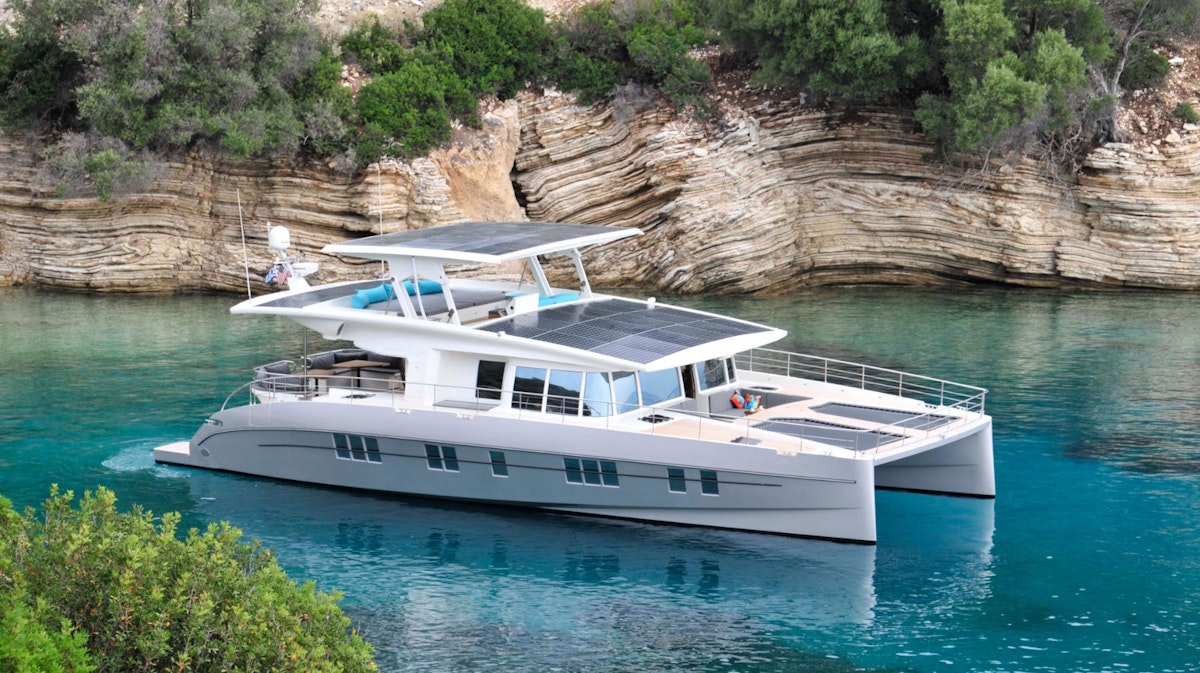
Silent Yachts
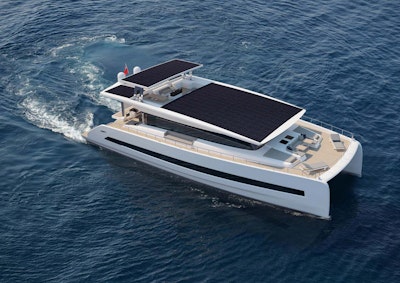
Silent Yachts 80
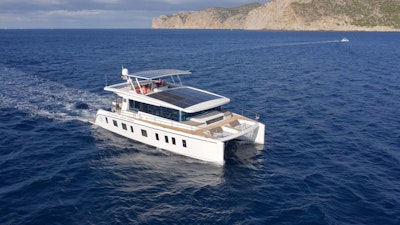
Silent Yachts 55
Speak To A Silent Yachts Sales Professional
Silent Yachts offer an environmentally conscious choice when it comes to owning a yacht. Silent Yachts currently offers three solar-powered power catamaran models including the Silent 55, Silent 64, and Silent 80. United Yacht Sales is proud to be the U.S. distributor for Silent Yachts and can assist you in your search for the world's first solar-powered yacht. For more information, please contact United Yacht broker Darren Sell at (561) 351-7333 or by email at [email protected] .
Where are Silent Yachts built?
Silent Yachts are built through two different shipyards depending on the model. The Silent 55 is built at the world-class shipyard of Mazarin German Yachts which also has a production site located in China. For over 70 years, Mazarin has been a leader in quality yacht construction with over 400 yachts delivered. Mazarin are experts in innovative construction processes that are able to produce light weight yachts.
The Silent 64 and Silent 80 are produced at the Italian-based shipyard Consorzio Navale which is a prestigous consoritum of builders and sub-contractors in the industry. The group has serviced many of the major Italian yacht brands such as Ferretti Yachts and Riva Yachts . Additionally, the Silent Yachts 80 features styling and design by Marco Casali and naval architecture by Insenaval.
Are Silent Yachts really completely solar-powered?
The short answer is yes. Owners can choose to go 100% solar-powered or install diesel engines should higher speeds want to be achieved over longer distances. Silent Yachts can cruise up to 100 miles per day by power acquired through its solar panels. Every day the solar panels are able to generate more power than the total consumption needed for propulsion at cruising speeds plus powering all of the appliances on board.
How does the solar power work?
The Silent Yachts power system feeds the electric propulsion of the power cat and all of the energy it needs to run the A/C, refrigerators, and other household appliances. Light-weight lithium batteries provide an ample amount of energy for everything on board. The lithium batteries used in Silent Yachts are the most expensive ones on the market, but also the most reliable, safe, and have the longest life span.
Solar panels are integrated to the roof of the flybridge hardtop sections instead of just being bolted on top, resulting in no wind load or resistance againest them. Below is a video explaining how the system functions and operates back when Silent Yachts were originally called "Solar Wave":
Who is the team behind Silent Yachts?
Heike and Michael Kohler have sent almost their entire lives on a boat. After more than two decades of using various boats, cruisers, and sailboats on multiple oceans, they became dedicated to finding a better energy source for the propulsion of yachts. Between the years of 2005 and 2009, Heike and Michael tested a number of a multitude of various alternative energy sources. In 2009, SolarWave 46 was launched as a proof of concept for their design. While there are many boats and yachts built that use solar power in some fashion, the Solarwave 46 was the first ocean-going yacht to use solar energy to power everything on board from engines to appliances.
What else is different about how Silent Yachts are built?
Certainly the solar-powered engines and generators are the distinguishing characteristic, but there are a lot of other features that make each Silent Yacht unique. For example, the molds were created using a CNC-milling machine that is able to contruct particular shapes for an optimized design. The materials used in the hull include a carbon compositie that is then resin-infused for a light-weight, but very strong platform. Every hull is fully insulated and the long-term durability is exceptional thanks to the high-quality resin used in the infusion process.
What propulsion systems are recommended by Silent Yachts?
Silent Yachts recommends the 2 x 135 engines as the best solution. If the owner is making frequest trips from Point A to B (Say Miami to the Bahamas for example) the faster hybrid is recommended. The main differentiator here is cruising speed. If the owner is living on the yacht for an extended period of time, rarely pushes the engines to top speeds, and stays below 12 knots, then the E-Power is recommended.

When the generator is running, does the 100Kw go to charging the batteries (which run the 250 Kw e-Motors) or directly to the e-Motors?
All of the enery consumers and producers are connected to the bus bar. If there happens to be more power produced than consumed, the excess power goes to re-charge the batteries. If for some reason more power is required than what is produced, the needed power comes from the lithium batteries.
What is the sustained speed if both 100 Kw generators are running?
This answer really depends upon sea condition and the weight of the boat (for example components, additional equipment, water toys, etc.). The sustained speed on average though is between 12 and 14 knots, 10 knots with one generator running. It is possible to cruise at 10 knots without a generator running when using the Solar E-Power.
Worldwide Yacht Sales
- Million Dollar Yachts For Sale
- 6 Million Dollar Yacht
- Hiring A Luxury Boat Captain
- Boat Sales Charleston SC
- Used Boats For Sale in Alabama
- Bay Boats For Sale in Corpus Christi Texas
- Yacht Search By Location
- Boat Sales Massachusetts
- Used Boats For Sale Stuart Florida
- Yachts For Sale in Georgia
Luxury Boats & Yachts
- Center Consol Boats For Sale
- 2 Million Dollar Boat
- Broward Yachts
- Hinckley Boats For Sale
- Sabre 42 For Sale
- Yachts For Sale by Price
- Yacht For Sale USA
- Ocean Yachts For Sale
- Sailboats For Sale Texas
Popular Builders & Models
- Back Cove Boats For Sale
- Small Tug Boats For Sale
- 40 Sea Ray Sundancer
- Grand Banks Trawler
- Catamaran Boat For Sale
- Sea Ray 58 Sedan Bridge For Sale
- Express Cruiser For Sale
- Fast Boats For Sale
- Sea Ray 460 Sundancer For Sale
- Bavaria Yachts
Trending Brands & Types
- Luhrs Boats
- Bayliss Yachts For Sale
- Nordhaven Yachts
- Jarrett Bay Grander
- Silverton For Sale
- Vanquish VQ32 For Sale
- Used Boston Whaler For Sale
- Regal Boats Prices
- Hcb Yachts For Sale
- Hatteras Motor Yacht
- Carver Yachts For Sale
- Tartan Sailboats For Sale
- Buddy Davis For Sale
America's Most Trusted Solar Marketplace
Please enter a valid zip code.
- Why Solar.com?
- Solar Calculator
- How It Works
- Learn About Solar
- Installer Reviews
- No menu assigned!
Solar Learning Center
--> Solar Pros & Cons
- Lower Electric Bill
- Increase Your Home Property Value
- Gain Energy Independence
- How Solar Benefits the Environment
- Disadvantages of Solar Energy
- Solar Panel Scams
- Time-of-Use Rates (TOU)
--> Solar Panels for Home
- Best Solar Panels
- How Do Solar Panels Work?
- Solar Panel Efficiency
- Solar Inverters
Solar Providers Near Me
- Solar Panel Installation
- Charging an EV with Solar Panels
Community Solar
Solar for condo owners, key solar terms, --> solar panel cost.
- Solar Cost Calculator
- How Much Do Solar Panels Save?
- Solar Panel Installation Cost
- Solar Panel Costs by State
- Solar Cost Per Watt
- Solar Panel Maintenance Requirements
--> Solar Financing
- Buy Solar Panels
- Solar Loans
- Solar Lease
- Power Purchase Agreement
--> Solar Rebates & Incentives
- Federal Solar Tax Credit
- Solar Incentives by State
- What are Solar SRECs?
- Inflation Reduction Act of 2022
- ITC Step Down: Effects on Solar Installation
--> Solar Battery
- How Do Solar Batteries Work?
- Solar Battery Price
- Battery Backup vs Generator
- Enphase Battery
- FranklinWH Battery
- Tesla Powerwall
- LG Batteries
- Off Grid Solar System
--> Solar FAQs
- General Solar.com Questions
- Project Financing
- Creating a Solar.com Account
- Solar.com Bidding Process
- Solar.com Installers
See how much solar panels cost in your area
Zero upfront cost, best price guaranteed.
Solar Learning Center > Solar Panels for Home > Solar Panel Installation Process > Solar Panels For Boats and Yachts Solar Learning Center > Solar Panels for Home > Solar Panel Installation Process > Solar Panels For Boats and Yachts -->
Solar Panels For Boats and Yachts

By Michael Olenick | Jul 26, 2022
The purchase of a boat or a yacht is a coveted purchase for many people. While it certainly adds a new dynamic to one’s life, it’s not the most straightforward investment since maintenance is a huge component of owning a sea vessel. Other than the physical maintenance of your boat, fuel management and maintenance is often a logistical nightmare for many boat owners. Some of these problems include keeping batteries topped off; doing it quietly, as not to bother the surrounding communities; and refueling costs. An easy solution to these problems: solar panels.
Sizing a Solar System for Your Boat or Yacht

- Refrigerator(s)
- Radar & sonar units
When adding up your energy consumption, always round up and add about 10-15% extra Watt-hours to your total, as certain appliances tend to use up more energy during spring and summer months. Once you reach the conclusion that you are ready for a further discussion, you can always reach out to a solar panel expert to get solar quotes, help with your energy calculations, and aid in determining the right number of panels you would need to offset your yacht or boat’s energy usage. Obviously, the number of panels you would need depends on energy usage and vessel size, but solar is a much better option than common fossil fuels when powering your boat.
The Benefits of Adding Solar Panels To a Boat or Yacht
When it comes to adding solar panels to your boat, the benefits are endless. Here are just a few for you to consider:
- Silence: Noisy refueling at docks and extremely loud on-board generators are a thing of the past. Cruise the seas in with zero mechanical noises, and enjoy the natural ocean sounds.
- Minimal Maintenance: The only maintenance solar panels require is a simple rinse off every couple of months, as salt can build up when the seawater evaporates.

- Travel Lightly: With your new panels, you won’t have to lug heavy containers of fuel with you on your trips. More room for wine or martini mix.
- Unlimited Energy: Aside from the occasional cloud in the sky, you will have full access to the sun on the open seas.
Besides the affordability and convenience, solar panels could inevitably save your life. You will never have to worry about running out of fuel when you are out on the water. This will help you avoid any potential emergencies or disasters.
Solar Panel Placement
This is where most caution needs to be taken. When choosing where you are going to place your solar panels on your yacht or boat, you need to take two big things into consideration: shading and security.
When it comes to shading, you want to make sure you place your panels in an area that receives the most sunlight. Having your boom shade some of the panels, or any lines can reduce your energy production. The wiring of solar panels can also be delicate. That is why you need to place your solar system in the most secure spot possible – rough seas or choppy waters could lead to a wire shaking loose.
If you’re longing to make a maintenance upgrade to your nautical vessel, a solar system should be seriously considered. Not only will it reduce noise, weight, and fueling costs, but it will differentiate your boat from all the other vessels at your next port.
Whether you have questions about panel placement, efficiency, or just if your boat is right for solar, please click here to speak to an expert!
Solar Panel Installation Process
More related articles.

Solar Panels on a Flat Roof: 5 Things to Know
Can you install solar panels on a flat roof? Yes, you can successfully install solar panels on the flat roof of your home or business....

How Many Solar Panels Do I Need To Power a House?
One of the first questions homeowners ask when going solar is “How many solar panels do I need to power my home?” The goal for...

What Is the Best Roof Design for Solar Panels and What If...
If you’re looking to go solar at home, chances are you’re going to put those panels up on your roof. Ground-mounted solar is a great...

The Best Roof Materials for Solar Panels - 5 Common Materials
One of the first questions you’ll be asked in the process of going solar is, “What is your roof made of?” Solar can be installed...

How Long Do Solar Panels Last on a House?
Like buying a house, solar panels are a long-term investment. The longer you own them, the greater the return on investment. In fact, if you...

Meet the Energy Companies Topping the Inc. 5000
Last month, the annual Inc. 5000 list was published on Inc.com. The list ranks businesses based on their revenue growth from 2013 to 2016, and...

The Value of Custom Designed Solar Systems
When customers come to us from other installers, they are always hesitant and anxious. Why? Because when you go straight to the installer they give...

3 Questions To Ask Before You Go Solar
Most solar installation companies provide financial projections to homeowners estimating what their savings will be twenty or twenty-five years after the time of installation....

The Influence of Women in the Solar Industry
It’s International Women’s Day! Today we recognize and celebrate women all around the world. As a member of Solar.com’s female population, it’s necessary for me...

Who Are The Best Solar Panel Manufacturers?
You are a savvy consumer who wants to make sure you find the best solar panels for your home. In a lot of instances,...

2021's Top Solar Monitoring Systems
Household solar monitoring systems change the abstracts of power generation and consumption into graphics and numbers you can scroll through on an app. Hardware connected...

2021's Best Home Solar Mounting Systems
Solar panels and backup batteries get all the attention. But there’s another important piece of equipment to the home solar equation: mounting systems. These sturdy...
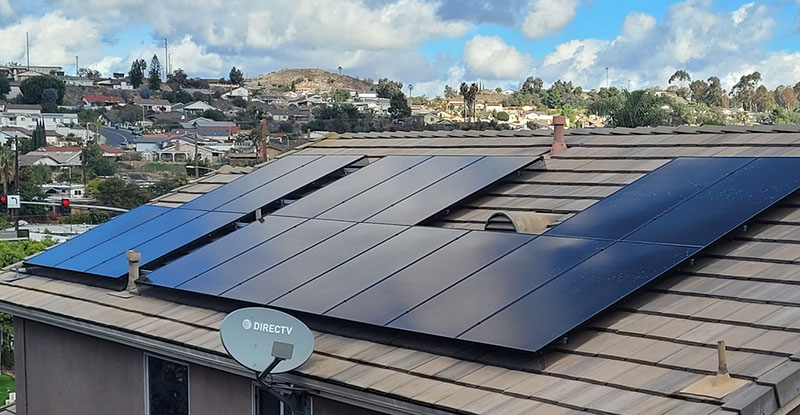
How To Choose The Best Solar Panels in 2023
Solar panels last a very long time and technology is always improving. How do you decide which panel is the right fit for you? Should...

Our Solar COVID-19 Guidelines
Solar.com is committed to providing our customers with the best customer service experience in the solar industry. In light of the ongoing developments around the...

U.S. Installed Solar Capacity: 2 Million Milestone
According to the most recent data released by Wood Mackenzie Power & Renewables and the Solar Energy Industries Association (SEIA), the residential solar market in...

Solar Subcontractors: Should I use one to go solar?
So, you’re interested in starting a solar project and now you’re wondering, “who should be doing the installation work?” Well, more and more companies...

5 Most Popular Solar Panels Chosen by Homeowners in 2018
Homeowners demand a lot from the solar panels they select for their rooftop system. These panels need to look good and perform well over multiple decades! Here...

Better Looking Solar Panels: System Aesthetics Comparison
As a homeowner, solar panel efficiency and cost may not be the only two factors you’re considering when deciding whether or not to go...

Brooklyn Solar Works Solar Canopy: The Comprehensive Review
As everyone knows, space is tough to come by in New York City. The same holds true when designing rooftop solar arrays. The city is...

8 Awesome New Technologies from Solar Power International 2018
Today, the Solar.com team took a break from our solar designs for a quick trip down to Anaheim for Solar Power International 2018. We...

The Essentials of Passive Solar Home Design
In the process of designing a home, there are a number of strategies that can be implemented to minimize the amount of energy required to...

South Korea's Q CELLS to Open Georgia Solar Factory
In the wake of US tariffs on non-domestic solar modules, Q CELLS is opening a solar module factory in Georgia. The South Korean company announced...

What Direction Should My Solar Panels Face?
When you make the decision to install a solar panel system at your home, there are going to be several questions on your mind. How...

India Gets Serious About Solar
According to Indian Prime Minister Narendra Modi, India is on track to install 200 gigawatts of renewable capacity by 2020. The country is fully embracing...

Can My Solar Panels Withstand a Hurricane?
If you live in an area that experiences extreme weather like hurricanes, hail, thunderstorms, blizzards, heavy winds and more, then you should take the...

Why Are Solar Panels Blue?
If you have ever driven through a residential neighborhood in states like California, Arizona, North Carolina, or any of the other top states for solar,...

What Solar Options Are There Besides Rooftop Solar?
When you think of solar, you probably imagine a solar panel-lined rooftop. For many homeowners, rooftop solar is usually the way to go. But it...

Brand Battle: Hyundai vs. Panasonic Solar Panels
Hyundai and Panasonic are trusted brands and they’ve both expanded into the solar panel industry. Offering quality products for two different price points, each brand...

Why New York Loves SunPower Solar Panels
New York loves its Yankees — and its Sunpower solar panels. A recent review of the Solar.com platform showed that homeowners in New York state...

Should I Get a Solar Thermal System Instead of a PV System?
When you hear about installing solar, you’re most likely hearing about PV (photovoltaic) solar cell panels. They’ve become standard in the industry. PV solar cell...

How to Conduct Due Diligence on Your Solar Project
Once you’ve decided to install a solar panel system at your home, the next thing to focus on is conducting the proper due diligence on...

How Utility API Works With Your Utility and Solar Company
Utility API provides software to accelerate the clean energy movement. They do this, in part, by offering secure data on a homeowner’s energy usage to...

What's the Size of a Solar Panel? Solar Panel Size and Weight...
If you are thinking about installing a solar panel system at your home, one of the first things you must consider is how much...

American Solar Panel Manufacturers - 2018 Complete List
There are many reasons why a consumer may want to purchase their solar panels from an American manufacturer or from American Solar brands. They want...

A Guide to Solar Panel Mounts
Solar panel mounts are a common component of almost every solar panel array. Although there are newer solar panel technologies coming out that do not...

Top 5 Solar Panels Selected Through Solar.com in 2017
Curious which solar panels are selected most on the Solar.com platform? As an online marketplace connecting quality solar companies to customers, we stay neutral...

SunPower Solar Panels vs. LG Solar Panels - 2018 Update
SunPower and LG are two of the top companies making solar panels. You’ve probably come across them in your research, and you’re wondering which will...

How Blockchain And Solar Can Work Together
Many would consider 2017 to be the year of cryptocurrency. Coins like Bitcoin, Litecoin, Ripple and dozens of others have shot up 1,000%+ and do...

The Craziest Solar Technologies Coming in 2018
Solar technology has been in existence since 1876 when William Grylls Adams and his student researcher discovered that you can produce electricity by exposing selenium to...

3 Solar Panel Innovations to Look for in 2018
Solar energy is taking shape across industries and geographies. Engineers at top solar panel companies are hard at work developing innovations making solar even more...

6 of the Most Common Solar FAQs
Solar is now more affordable and practical for the consumer than ever before, and because of this, it is starting to make sense to think...

An Overview of Panasonic's Solar Panel Offerings
With all of the advances in the solar industry, it is getting more practical and affordable to start using solar. In fact, the price of...

5 Reasons to Consider a Career in the Solar Industry
Solar energy, unfortunately, is still viewed as an alternate power source. However, in spite of this designation, it is quickly becoming the primary source of...

Installing Solar in Nepal
Working in the energy sector in America can be fast paced. It is primarily focused on reducing homeowners energy bills. Cost is king. My days...

How To Properly Evaluate Solar Panel Companies
There are so many details to take into account when choosing the right solar system for you. One of the most important factors is,...

Installing Solar On Spanish Tile Roofs
Spanish tile refers to the style of the tile, not the material. Spanish tile is usually made of either clay or concrete. Installing a solar...

Invisible Solar Cells - What Are They?
We have come a very long way from the first line of solar panels. Despite their sustainability, the first solar panels were not the most...
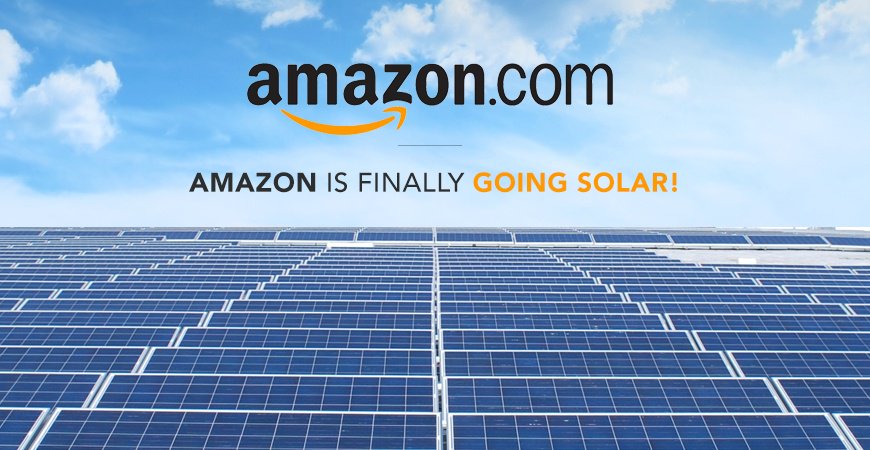
Amazon Has Finally Decided To Become A Leader in Renewable Energy
Back in 2015, Greenpeace did a sophisticated research project on the sustainability of the top tech giants in the United States. It covered many areas of sustainability,...

Solar Backup Power - Will My Solar Panels Work in a Grid...
Solar photovoltaic panels are created to absorb the sun’s energy and convert it to usable AC energy in your home. You may be wondering then,...

A Review of LG Solar Panels - When Brand Name Does Matter
LG is a brand you may already be familiar with. They are a South Korean multinational manufacturer that makes televisions, mobile devices, tablets, smartwatches and...

Will Tesla's Solar Panels Change The Industry?
On October 28, 2016, Elon Musk unveiled Tesla’s solar roof product – a line of roof tiles and shingles with embedded photovoltaic cells. To an...

Electrical Panel Upgrades for Solar: A Technical Case Study
John Smith is a homeowner in California looking to reduce his electric bill by going solar and he decided to call an installation company that...

SunPower Solar Panels vs. LG Solar Panels
If you are considering installing a solar system at your home or place of business, then you have many factors to consider. The paramount factor...
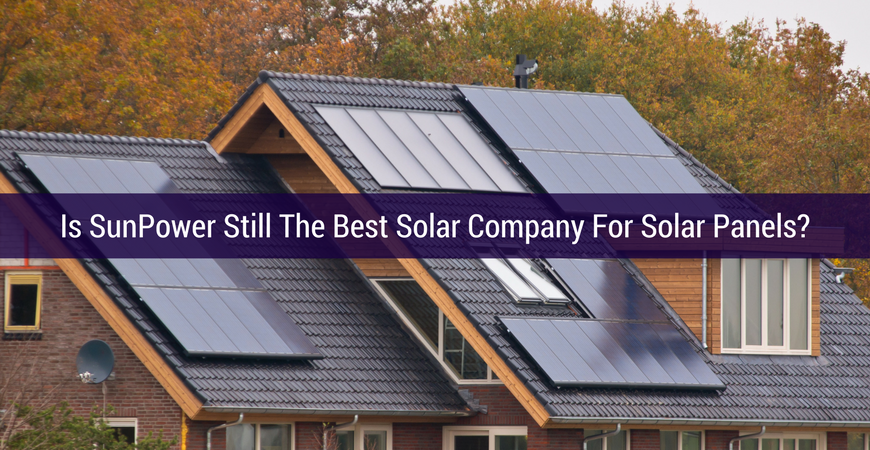
Is SunPower Still The Best Solar Company For Solar Panels?
You’ve heard of SunPower, LG, SolarWorld, Q CELLS, and maybe even Canadian Solar, but which one is the right fit for your home? To figure...

What Trump's Presidency Means for the Solar Industry
The election of Donald Trump to the office of President of the United States is expected to have a profound impact on the future of...

Importance of Power Tolerance in Solar Panels
This paper highlights the importance of power tolerance when choosing solar panels. Power tolerance is a measure of how much electrical power a solar panel...

Gauging the Bankability of Small to Mid-Sized Solar Installers
The entire world is going green and moving toward cleaner sources of energy. California hosts a flourishing solar industry with a burgeoning number of solar...

Ann Arbor Takes Steps to Promote Residential Solar
Home to Michigan’s largest solar panel array of 1.1 MW and one of the top green research universities in the country, Ann Arbor has a...

Measuring Home Energy Use
One of the most important steps before installing home solar is figuring out how much energy your home uses, and how big your solar energy...

Three Things to Avoid When Installing Your Solar Panel System
At Solar.com, we have a lot of experience in the solar panel industry. Every day we help people to install panels on their homes, and...

The Benefits of Floating Solar Panels
Floating solar panels utilize the same technology as the panels that you put on your roof. The main difference is that they’ve been adapted...

The Top Three Solar Manufacturers
At Solar.com, we believe in supplying quality equipment for our customers. In the last twenty years, solar technology has grown exponentially, costs have plummeted, and...

Elon Musk's Gigafactory Should Be Dictating Your Solar Equipment
All solar installations today should be thinking ahead to the not-so-distant future. The main question to be asking is whether your solar system will seamlessly...

The Solar “Tipping Point” is Looming
We all know why people go solar: investment purposes, immediate savings, environmental concerns, and grid independence. But who are these people? One of Malcom Gladwell’s...

4 Mistakes Homeowners Make When Going Solar
Buying a solar system for your home can be a confusing process. At Solar.com we’re committed to helping homeowners sort through it all and...

Solar Installation Horror Story
The following letter is from a very reputable company in Solar.com’s installer network to a homeowner who was unfortunately taken advantage of by an installer...

Bankability: What it Means and Why it is Important for Your Solar...
Homeowners who are considering solar typically overlook the manufacturer of their solar panels, despite this being one of the most important factors for the longevity...

How ‘Big Data’ Will Change The Solar Industry
The U.S. Department of Energy invests in new technology to revolutionize the landscape of solar data. Reliable solar grid data, the true performance of solar...

Los Angeles Solar Installation Permit Process About to Get Easier
Here at Solar.com, we want to see solar panels on every compatible rooftop in the U.S. And while our plans for expansion are ambitious,...
See how much solar panels cost in your area.
Zero Upfront Cost. Best Price Guaranteed.

How To Find the Best Solar Panels for Your Home in 2024
Trying to determine the best solar panels for your home is like trying to determine the best car – there’s no one correct answer. Everybody...

How Does Solar Power Work on a House? Your Questions Answered
How does solar power work? A simple explanation is that solar panels convert sunlight into electricity that can be used immediately or stored in batteries....
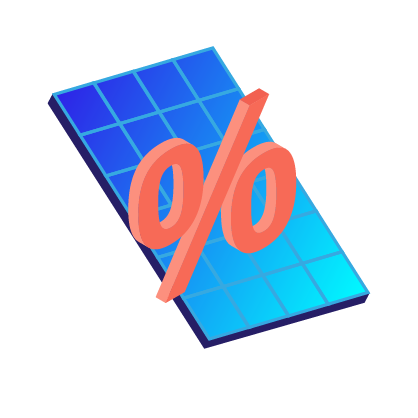
Solar Panel Efficiency - Pick the Most Efficient Solar Panels
You may hear the term “efficiency” thrown around a lot when reading up on solar panels. It sure sounds like a good thing, but what...

Solar Inverters: Types, Pros and Cons
What is a solar inverter? Solar energy doesn’t provide electricity in a format that your table lamp could be powered by. Inverters change the power...

When beginning your home solar project, you might start by searching “Solar Providers Near Me.” Then, you'll be presented with dozens of different solar companies...

Charging Your EV With Solar Panels and Using the EV Tax Credit To Lower the Cost
Ditching your gas-guzzler for an electric vehicle (EV) is a great way to lower the cost and emissions of getting from A to B. But...

It’s no secret that many of us spend a large portion of our income on energy and electricity bills. In fact, in 2012 we spent...

Solar for condominium unit owners is gaining steady popularity throughout the country, as more and more states are writing legislation to promote clean energy accessibility....

Going solar isn't something people do everyday and unless you have an electrical engineering degree, it's likely you'll bump into some new phrases and terms....
Join our free newsletter to learn more about going solar
lexus expands LY680 yacht's swimming platform and flybridge to fit a barbecue grill on deck
Lexus expands ly680 luxury yacht’s flybridge.
At the Japan International Boat Show 2024, Lexus unveiled the 1/20 scale model of its new LY680 Luxury Yacht , an upgrade of the previous LY650 water vehicle . Lexus’ latest model comes with an expanded swimming platform and flybridge to accommodate more guests on deck. The extended flybridge, which measures 1,400mm, now features a spacious lounge area and a dedicated barbecue grill, while the swimming platform has been expanded by 700mm to accommodate additional guests who wish to take a dip in the sea.
When Lexus conceived the idea for its LY680 Luxury Yacht, even before its debut at the Japan International Boat Show 2024 , the design team aimed to create a water vehicle that would feel like a ‘tranquil hideaway at sea.’ They imagined it as a moving space where ‘discerning customers could feel free and at ease.’ The resulting concept was a three-level luxury yacht equipped with living spaces that make the LY680 feel like a deluxe apartment on the sea.
The passengers enter the Lexus’ LY680 Luxury Yacht, and when they descend, they can find a kidney-shaped sofa nestled in one corner. Adjacent to the sofa is a desk with a plush seat, tailored as a workspace at sea for those who still need to hustle. Panoramic windows adorn the space, offering views of the waters and allowing natural light to flood in. The use of dark, varnished wood adds a sense of opulence to the interior, and across from the sofa and desk, a semi-circular bed invites passengers to relax while watching the waves and scenery through slanted windows.
1/20 scale model at Japan International Boat Show 2024
Walking up to the control area, the captain of Lexus’ LY680 Luxury Yacht navigates the water vehicle with ease through the expansive set of windows. The openness of the space is further enhanced by plush seating, two of them reminiscent of cinema seats. Even the wooden floors help brighten up the overall aesthetic. During the Japan International Boat Show 2024, where yacht enthusiasts could view the 1/20 scale model of the LY680, Lexus revealed that the luxury yacht can accommodate up to 15 passengers across three rooms with six beds.
Twin Volvo engines for Lexus’ LY680 Luxury Yacht
For those interested in specifications, Lexus’ LY680 Luxury Yacht is expected to be equipped with Twin Volvo IPS 1350/1050 engines and have a fuel tank capacity of 4,012 liters and a fresh water tank capacity of 852 liters. Production of the luxury yacht will be carried out by the Horizon Group, based on the Toyota Production System. Lexus has announced that yacht enthusiasts can reserve their water vehicle model through Toyota Marine sales offices in Japan and select dealerships. As of publishing, Lexus aims to deliver the first batch of the LY680 Luxury Yacht in Spring 2026, with international availability pending based on customer demand.
Lexus’ LY680 Luxury Yacht is expected to be equipped with Twin Volvo IPS 1350/1050 engines
project info:
name: LY680 Luxury Yacht
company: Lexus
event: Japan International Boat Show 2024
WATER VEHICLES (102)
DEEP underwater habitat with submarines builds research labs and livable homes on seabed
YACHT DESIGN (227)
Product library.
a diverse digital database that acts as a valuable guide in gaining insight and information about a product directly from the manufacturer, and serves as a rich reference point in developing a project or scheme.
- car design (790)
- electric automobiles (636)
- materials (60)
- recycling (316)
- car concept (355)
- space travel design (95)
- sculpture (349)
- turntable design (27)
designboom will always be there for you
Pennsylvania’s largest solar farm will replace its largest coal plant
Pennsylvania’s largest solar farm has been awarded $90 million and will sit on 2,700 acres of the shuttered Homer City coal plant’s land.
The Mineral Basin Solar Project will be located on Homer City’s former coal mining land in Clearfield County, west of State College. It will fill a critical electricity generation gap following Pennsylvania’s largest coal plant ‘s closure in July 2023.
Renewables developer Swift Current Energy (SCE) will build a utility-scale 402 MW solar farm capable of producing enough clean energy to power 75,000 homes. SCE says on Mineral Basin’s website that it’s considering adopting offsite battery energy storage for the project.
Mineral Basin will serve as a pilot for SCE, which plans to develop around 1,000 MW of solar on former coal mine sites in the Appalachian region over the next five years.
The federal funding for the solar farm was announced today by the US Department of Energy and came from money already earmarked by the Biden administration’s Bipartisan Infrastructure Law.
Secretary of Energy Jennifer Granholm said, “Thanks to the President’s Investing in America agenda, DOE is helping deploy clean energy solutions on current and former mine land across the country – supporting jobs and economic development in the areas hit hardest by our evolving energy landscape.”
The project expects to create more than 750 construction jobs and six operations jobs, while providing $1.1 million in annual tax revenue to townships, the county , and local school district.
Construction on Pennsylvania’s largest solar farm could begin this summer, and it’s expected to come online by the second half of 2026. The New York State Energy Research and Development Authority (NYSERDA) awarded it a 20-year power purchase agreement in November 2023.
Mineral Basin Solar Power, LLC, says it will invest nearly $20 million in economic development to create opportunities for young people and adults who want to upskill, right-skill, and reskill across high-demand sectors in the 27-county region.
To limit power outages and make your home more resilient, consider going solar with a battery storage system. In order to find a trusted, reliable solar installer near you that offers competitive pricing, check out EnergySage , a free service that makes it easy for you to go solar. They have hundreds of pre-vetted solar installers competing for your business, ensuring you get high quality solutions and save 20-30% compared to going it alone. Plus, it’s free to use and you won’t get sales calls until you select an installer and you share your phone number with them.
Your personalized solar quotes are easy to compare online and you’ll get access to unbiased Energy Advisers to help you every step of the way. Get started here . – ad*
FTC: We use income earning auto affiliate links. More.
Michelle Lewis is a writer and editor on Electrek and an editor on DroneDJ, 9to5Mac, and 9to5Google. She lives in White River Junction, Vermont. She has previously worked for Fast Company, the Guardian, News Deeply, Time, and others. Message Michelle on Twitter or at [email protected]. Check out her personal blog.
Michelle Lewis's favorite gear

MacBook Air
Light, durable, quick: I'll never go back.

Because I don't want to wait for the best of British TV.

IMAGES
COMMENTS
The Original Solar Yacht. As the original inventors of series produced solar-electric yachts, we pioneered this innovative approach. Our first model, the Silent 64, was launched to the market in 2016, several years before any other shipyard considered the possibility of going electric.
ALVA Yachts, the German builder of luxury electric solar catamarans and sail boats, has announced it is currently building the world's first fuelless 90ft superyacht catamaran with wings, the OCEAN ECO 90 H2. The first superyacht catamaran to run without fossil fuels and producing zero emission, the OCEAN ECO 90 H2 is designed with luxury ...
The perfect mid sized electric solar catamaran. The OCEAN ECO 60 is an innovation packed solar assisted electric long-range cruiser that will perfectly suit customers who like to cruise and explore while yachting.Designed with luxury, safety and cruising comfort in mind, it is an example of the latest technological developments in the field of self-sufficient yachts surpassing its competition ...
Our solar electric catamarans combine all the elements for a luxurious and environmentally conscious aquatic lifestyle. With zero CO2 or noise emissions on board, you can reconnect with your senses and fully enjoy the journey. electric models. The Soel Yachts portfolio offers solar electric catamarans for both private and commercial ...
The award-winning entry to solar-electric yachts As the successor to the Silent 64 (the first ever solar powered production yacht to cross the Atlantic Ocean during January of 2018), the 60 Series is equipped with the most refined, efficient and clever technology available today.
The blue water capable ZEN50 lightweight racing carbon hulls are combined with a huge solar roof for an unrivaled solar power vs. displacement ratio above 1:1 (18 kW / 17 tonnes), making this yacht completely energy self-sufficient. A revolutionary, fully automated, wingsail - by Ayro© - can be added as a range and speed extender.
The solar-powered Silent 64 is the first model to be built by Silent Yachts. The traveler, he noted, is at the mercy of the vessel's fuel -capacity. While the powerplant or generator is running, the fumes, constant noise and vibration can wear you down as much as sporty conditions and merciless sun. (And the need for maintenance increases.)
"The boat's house load is 5-10kWh per day," explains Jean-Marc Zanni, who designed the 55's electrical system using 140kWh of Panasonic batteries and the 370W Sunpower panels. "So you ...
6 Month. Electric catamaran 100% Solar Powered Unlimited Cruising Range Lifetime Maintenance-free Motors Carbonless Cruising | SILENT 80.
The very functional eco electric yacht gives its owner the ultimate freedom to go near and far at highest comfort while keeping the cost and emissions footprint at incredibly low levels. 42 state-of-the-art solar panels generate 18.5 kWp on the solar roof and let its user enjoy sustainable and luxurious yachting without any noise and high fuel ...
Eco-responsible shipbuilder Sunreef Yachts had given the public its first glimpse of its new 80-foot solar electric yacht before it makes it US debut in Fort Lauderdale, Florida later this month.
In addition to the wind kite option, the SILENT-60 yacht comes with 42 solar panels, garnering 17 kWp of energy from the sun to power two, 340 kW electric motors. The system is backed by a battery ...
Here are three of the best solar-powered catamarans: Sunreef's 80 Sunreef Power Eco Yacht. Silent Yachts' Silent 80. Soel's Senses 48. There are soo many variables that it's tough to say one is better than the others. No matter which you board, you're going to have a luxury experience. The benefit of these solar cats is that the ...
The 80 Sunreef Power Eco is a fully-electric luxury catamaran that could very well be one of the most advanced solar electric yachts built to date. Expand Expanding Close Electric boats
Silent Yachts is one of the leaders in the solar-powered yachts industry, having just launched an 80-foot tri-deck catamaran that is powered by more than 1,200 square feet of solar panels.
Here are a few pictures of the Aquanima 40 series solar yacht: Azura Marine claims that the vessel can continuously cruise thanks to its large 10 kW solar power system and 60 kWh battery pack.
The solar-electric yacht now features two OCEANVOLT 15 kW ServoProp sail drives, utilizing unique propeller blades that can change pitch to optimize efficiency and even regenerate power.
THE AVAILABLE SPACE. In practical terms, a modern 40ft monohull would have the space for around 1,200W of PV panels (cockpit arch, sprayhood top, deck), maybe 1,500W with the addition of a few portable panels for use at anchor. The 1,200W of fixed position solar array could produce around 360Ah on a sunny summer's day (zero shading) or more ...
Silent Yachts currently offers three solar-powered power catamaran models including the Silent 55, Silent 64, and Silent 80. United Yacht Sales is proud to be the U.S. distributor for Silent Yachts and can assist you in your search for the world's first solar-powered yacht. For more information, please contact United Yacht broker Darren Sell at ...
The solar electric catamaran then turns into a mobile power station and is able to feed 8.6kWp into the AC grid or provide power at remote places where no grid is available. ... The deck space of the solar electric boat can be customised to your wishes and host a variety of seating arrangements and layouts. Choose classic yacht fittings ...
Made from aluminum and advanced composite materials, the electric yacht's design maximizes the space for harnessing solar energy. With included solar panels built into the hulls, superstructure ...
The brainchild of Volkswagen, Silent-Yachts and Cupra, Silent 50 is a solar-electric catamaran that the intrepid trio hopes will revolutionise yachting by creating a more environmentally-friendly ...
The Benefits of Adding Solar Panels To a Boat or Yacht. When it comes to adding solar panels to your boat, the benefits are endless. Here are just a few for you to consider: Silence: Noisy refueling at docks and extremely loud on-board generators are a thing of the past. Cruise the seas in with zero mechanical noises, and enjoy the natural ...
1/20 scale model at Japan International Boat Show 2024 Walking up to the control area, the captain of Lexus' LY680 Luxury Yacht navigates the water vehicle with ease through the expansive set of ...
For home backup, Bluetti's AC200MAX is a powerful solar generator that allows you to stay off-grid while keeping appliances running. The 2,048 watt-hours battery capacity and 2,200-watt power ...
Pennsylvania's largest solar farm has been awarded $90 million and will sit on 2,700 acres of the shuttered Homer City coal plant's land. ... capable of producing enough clean energy to power ...